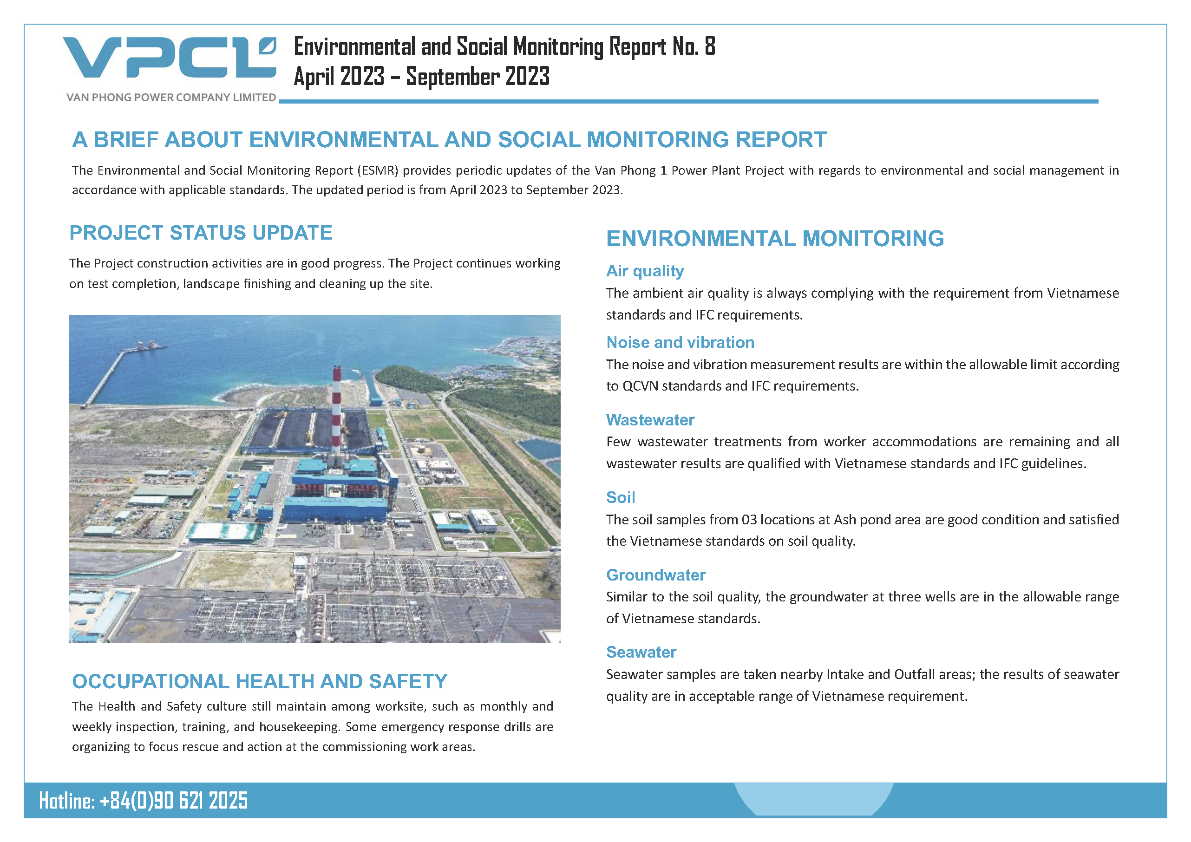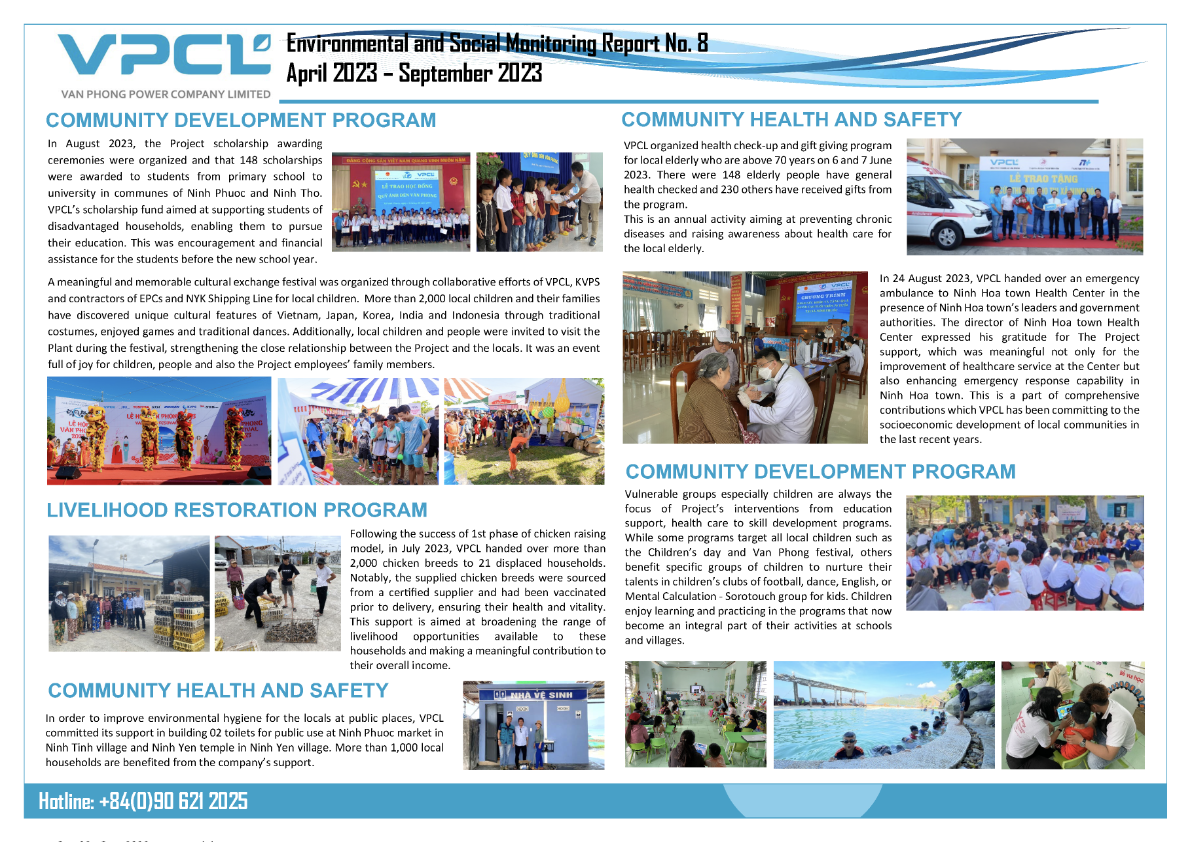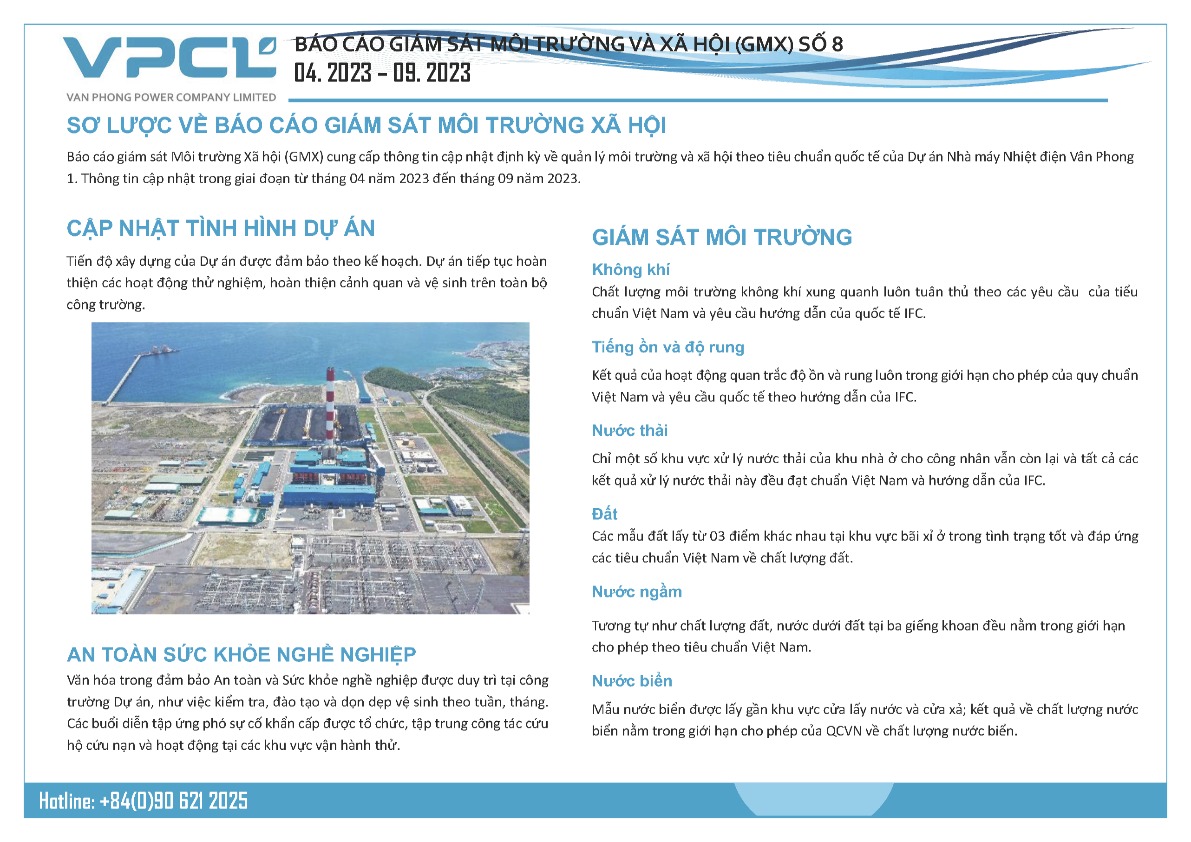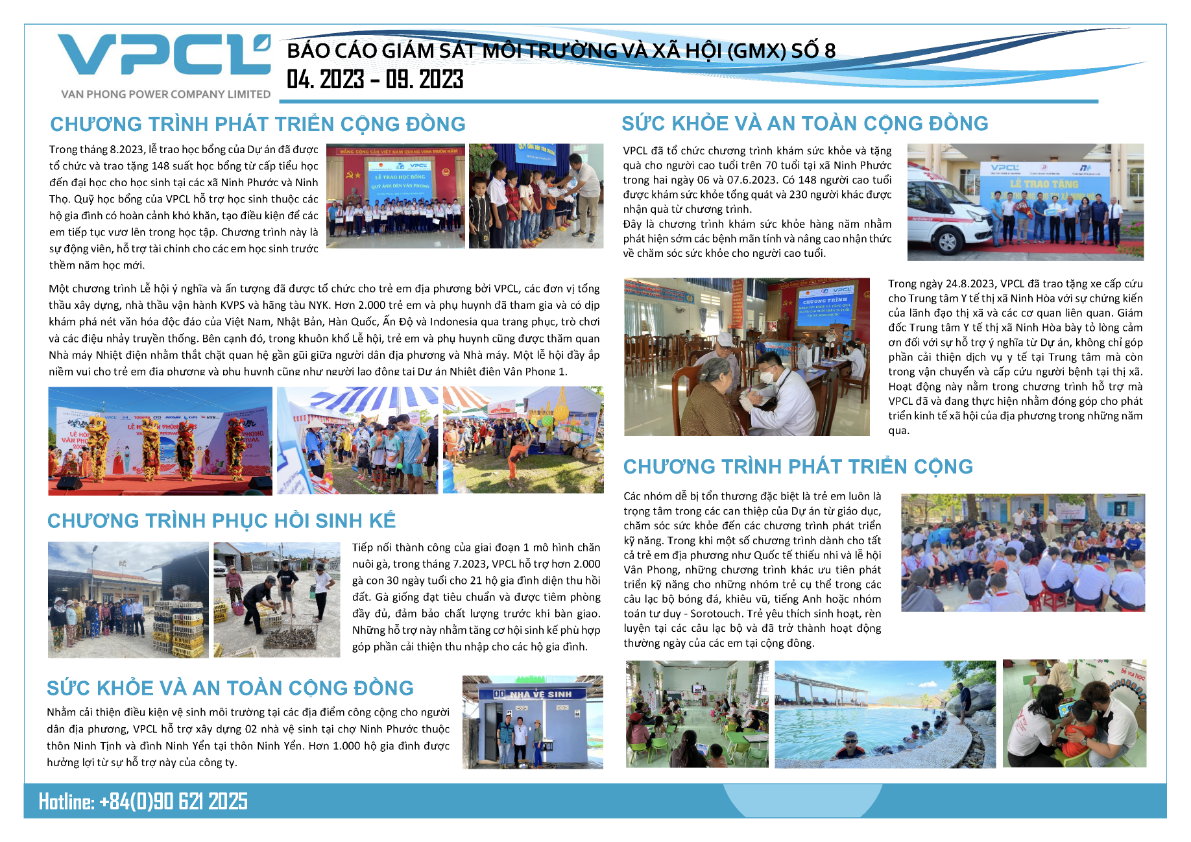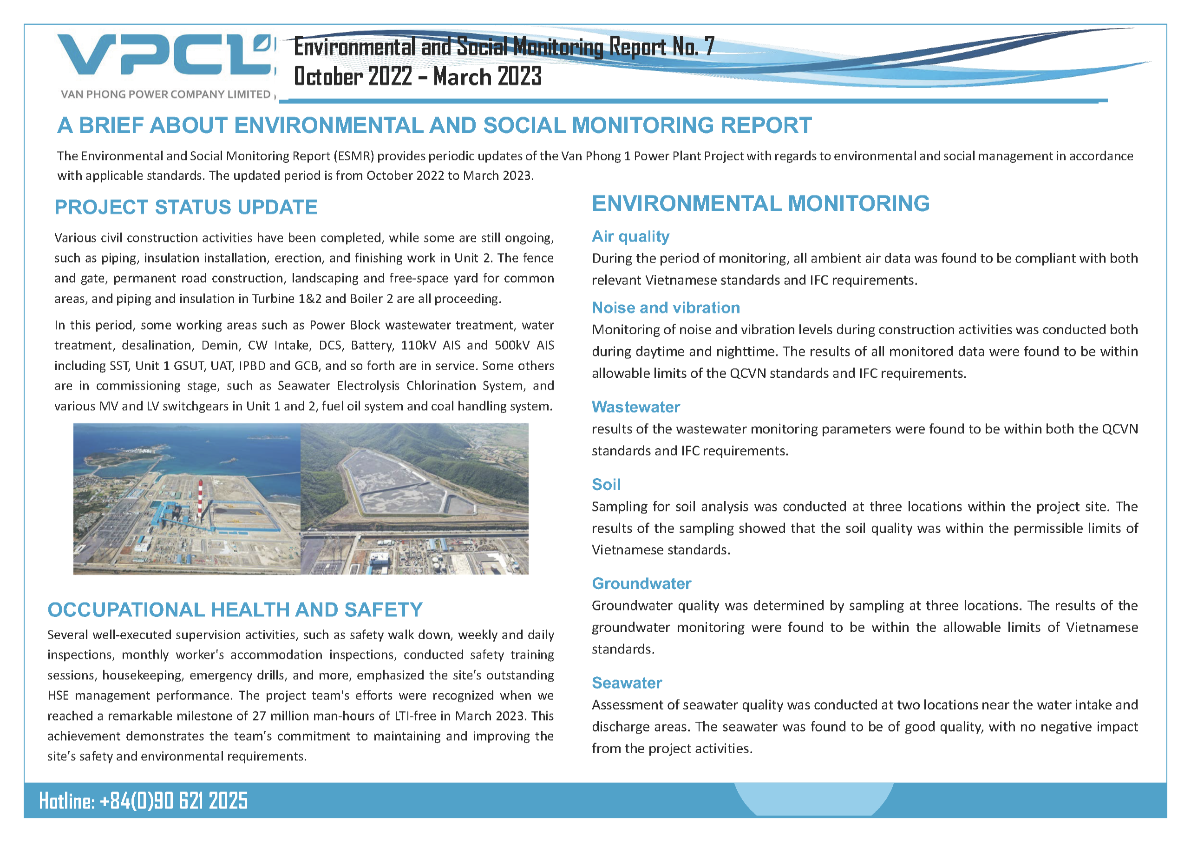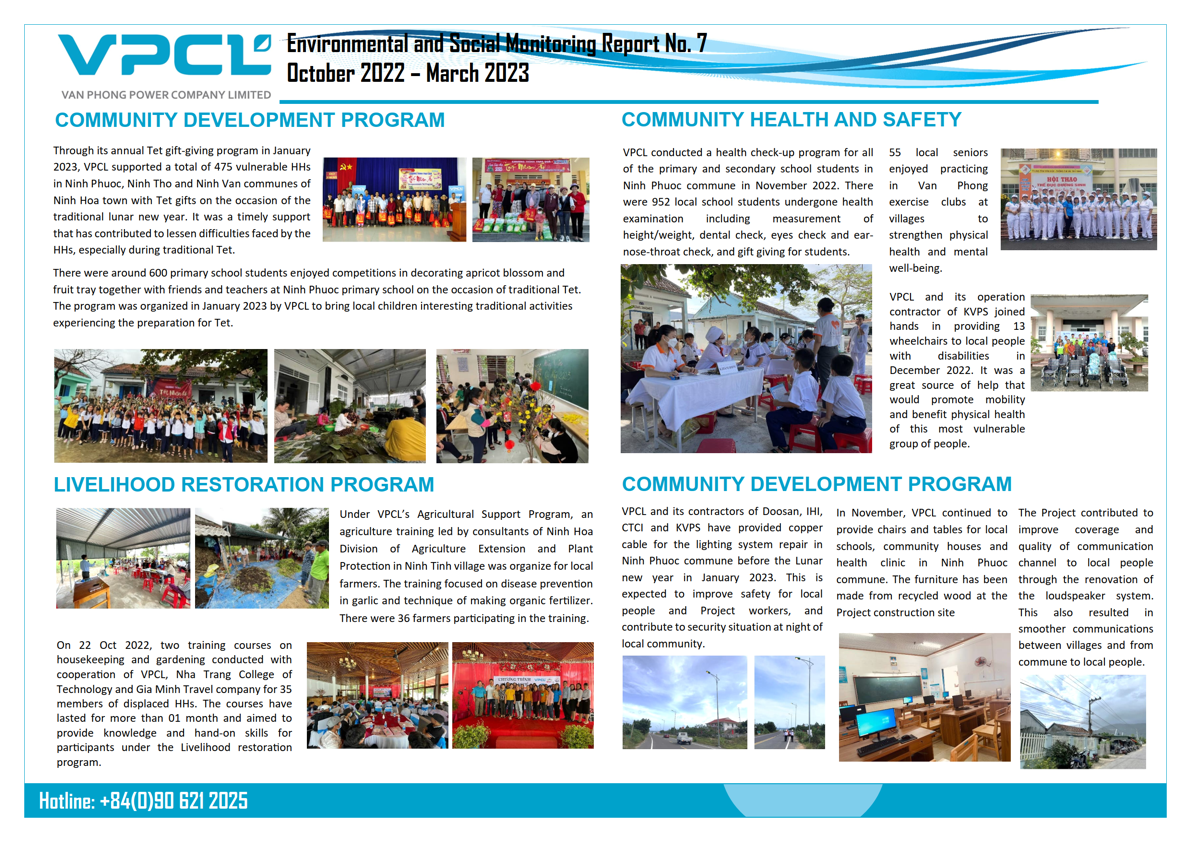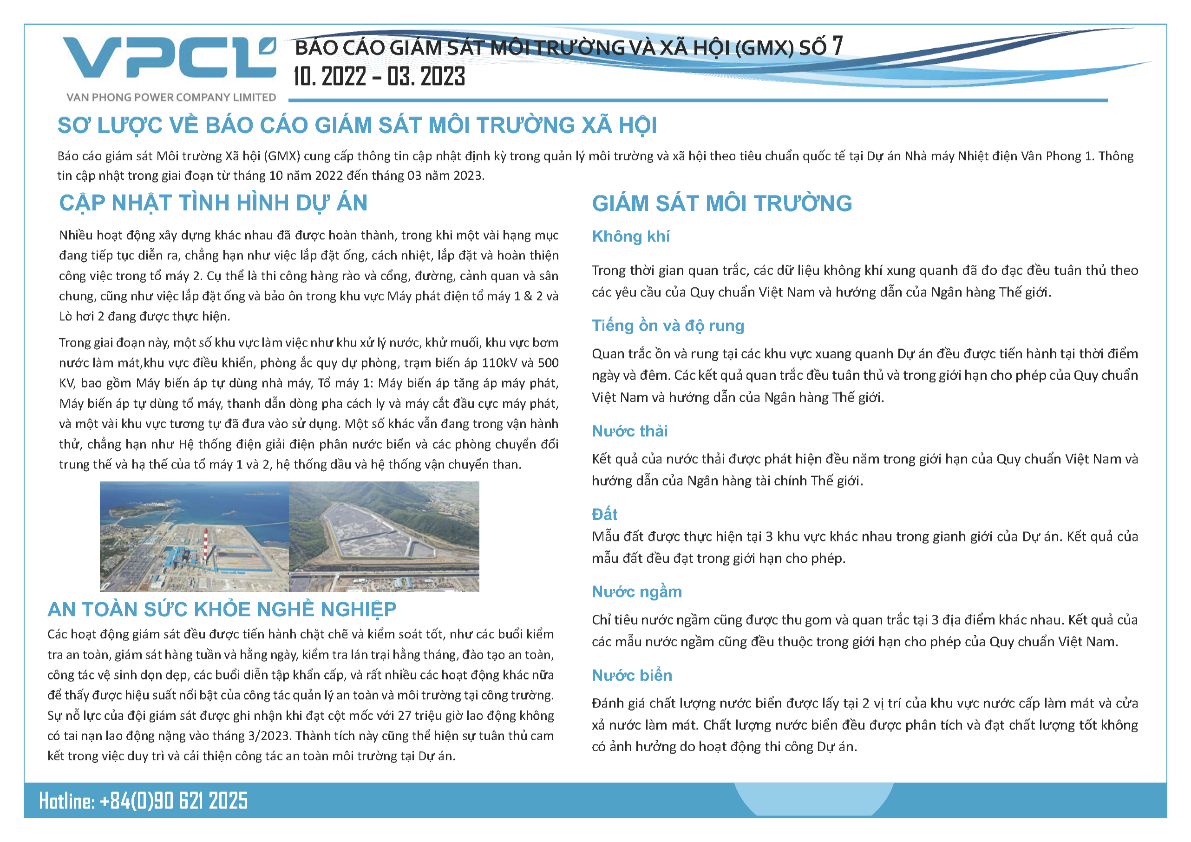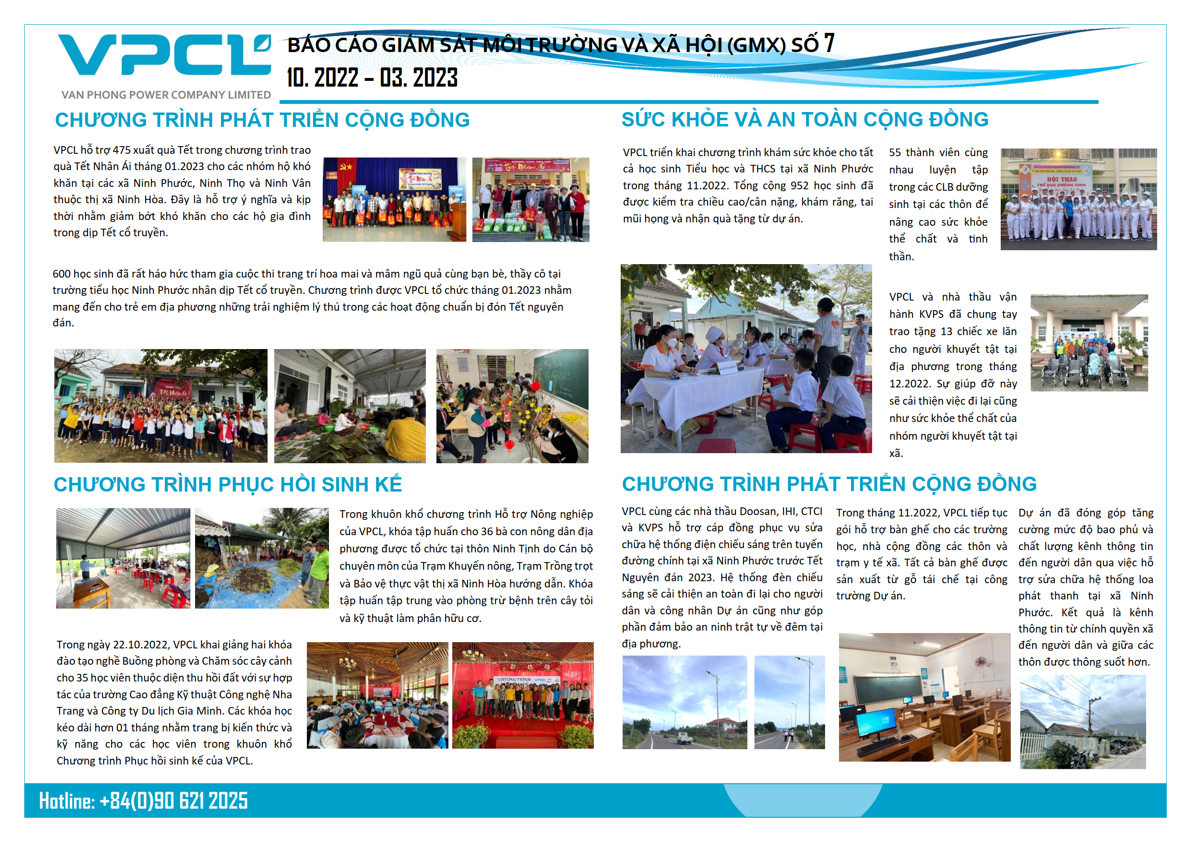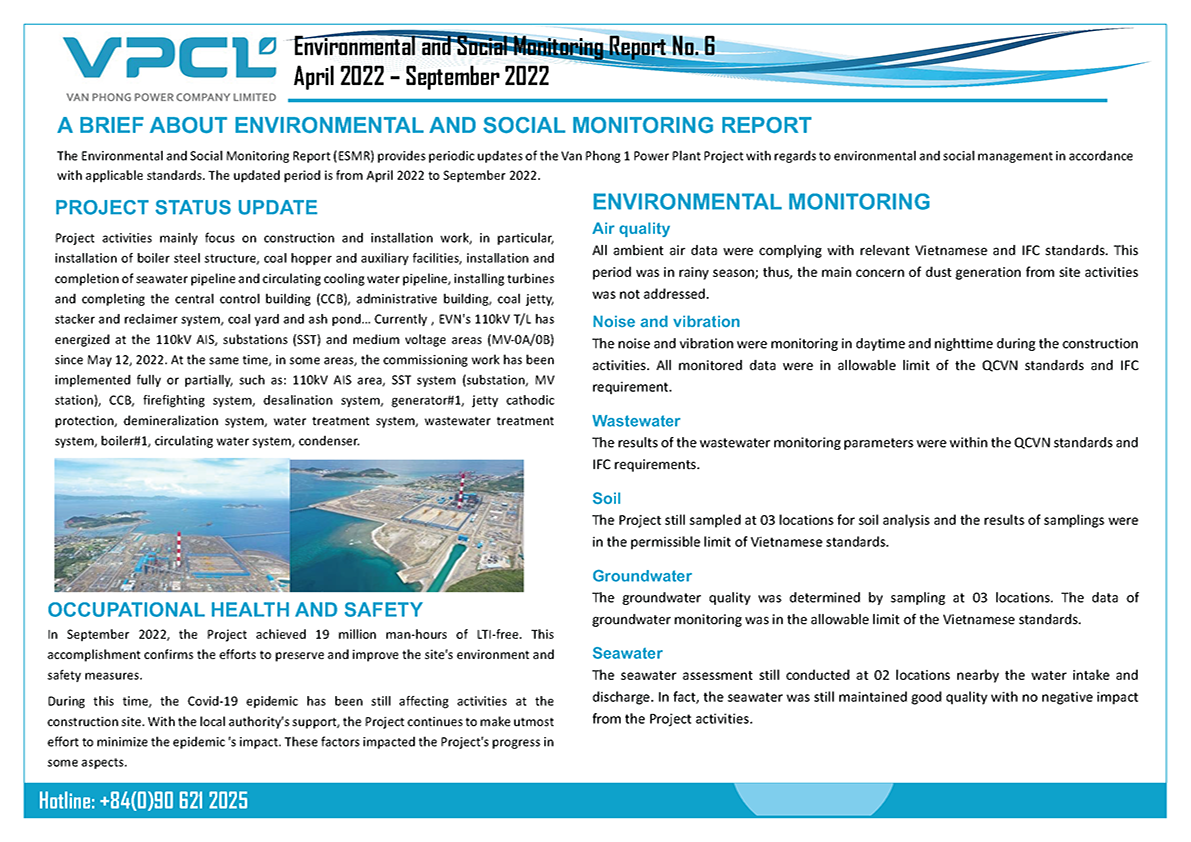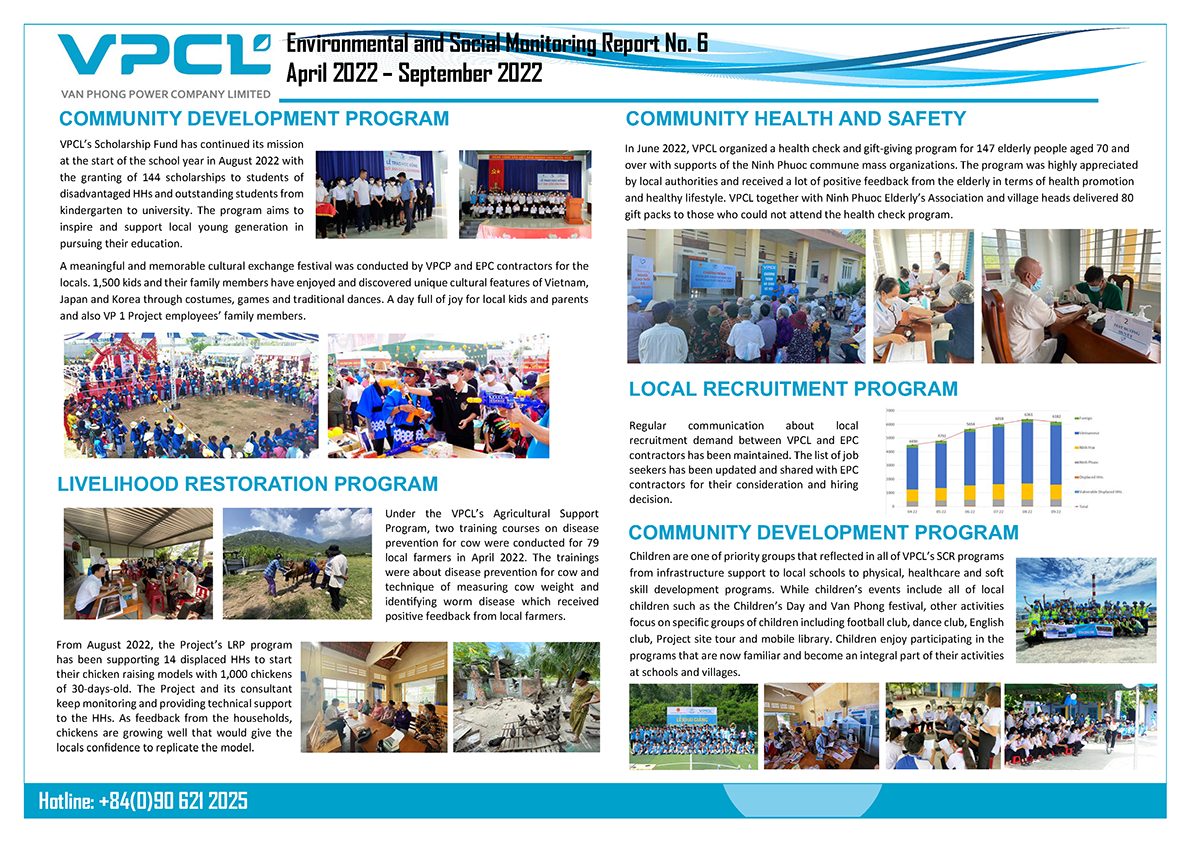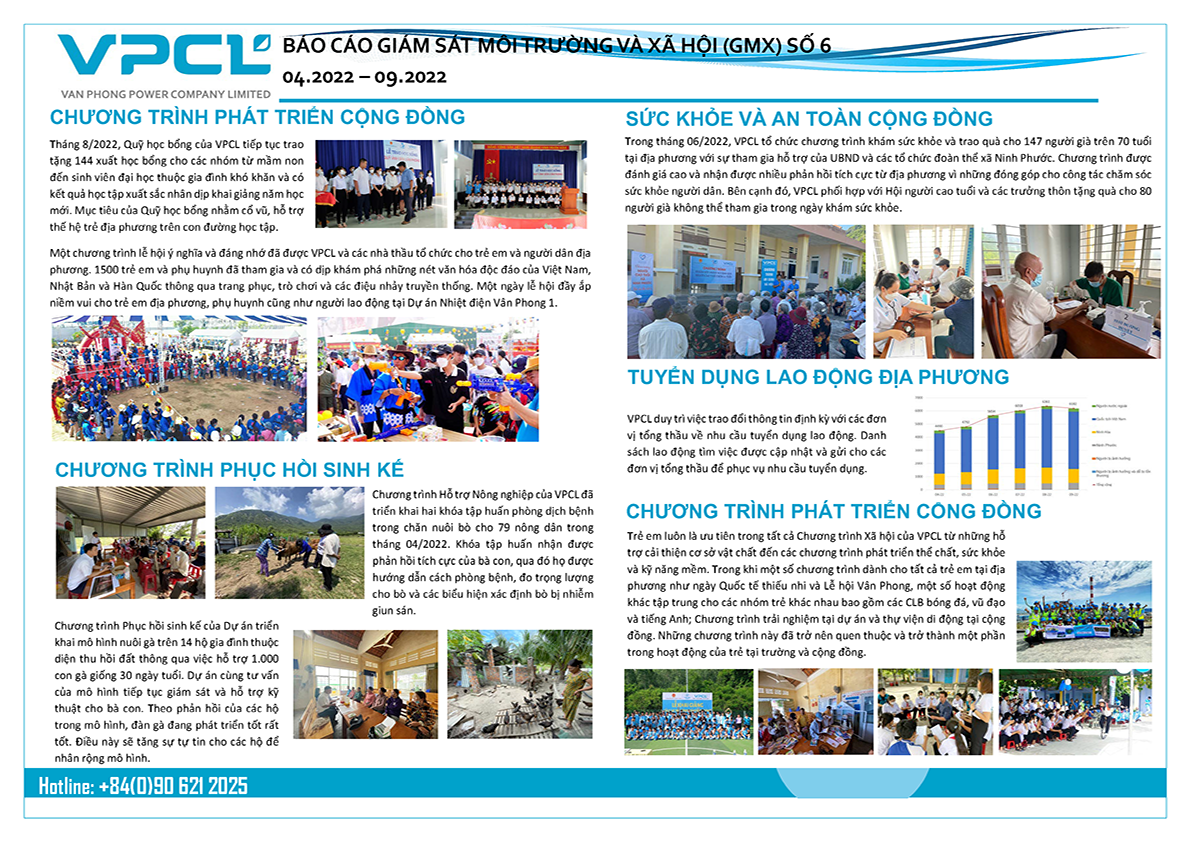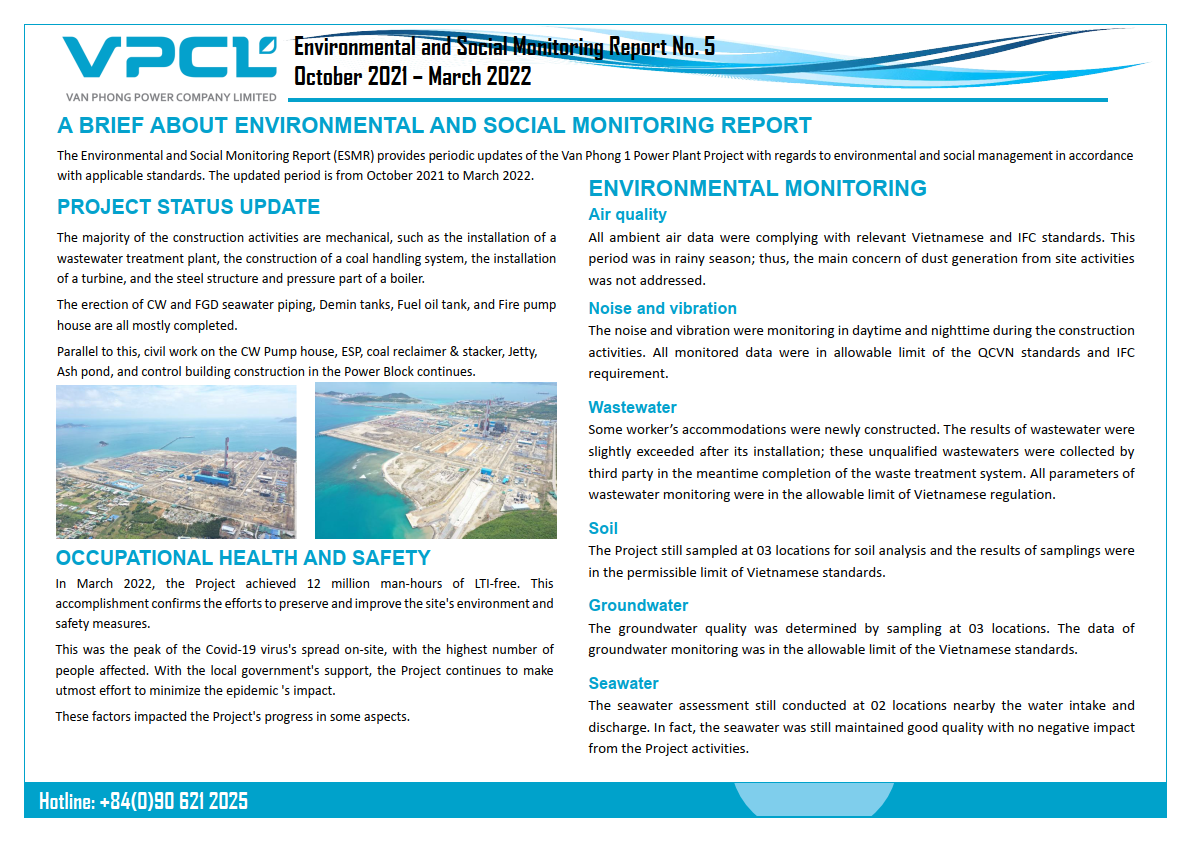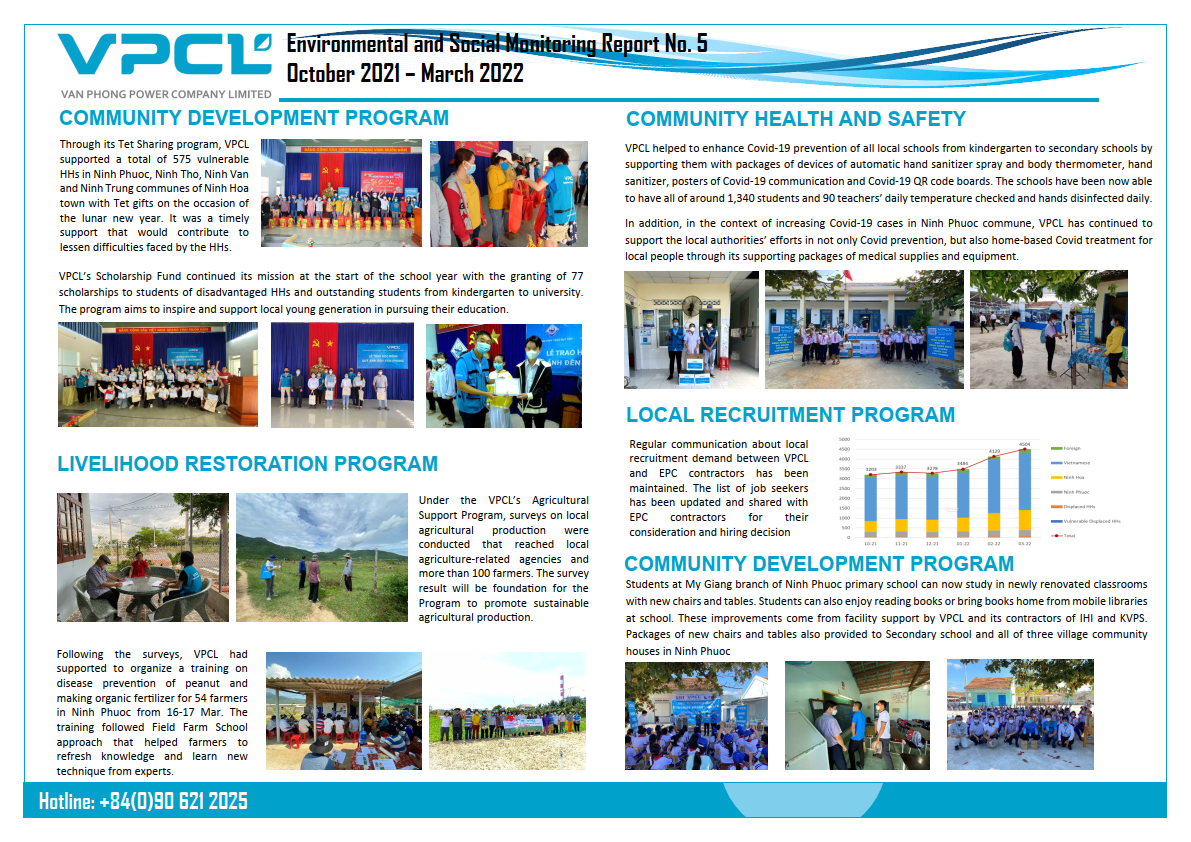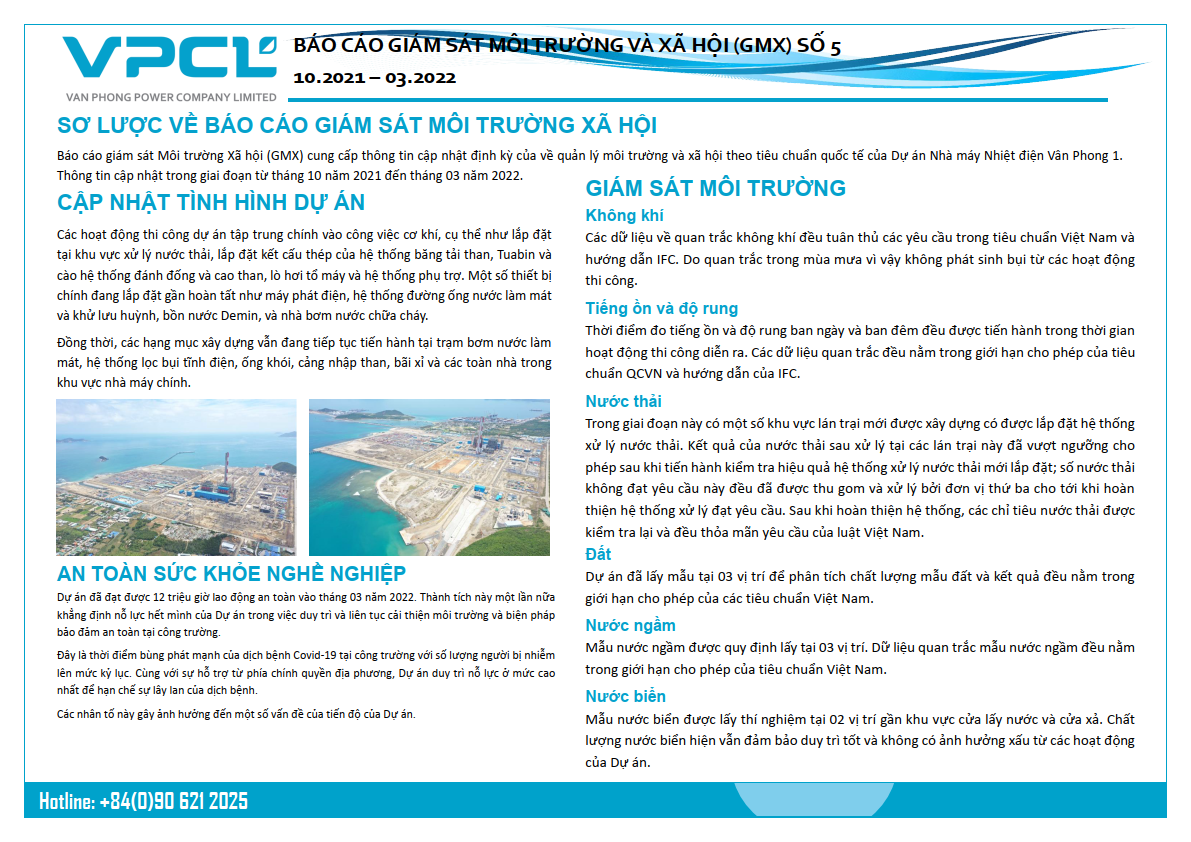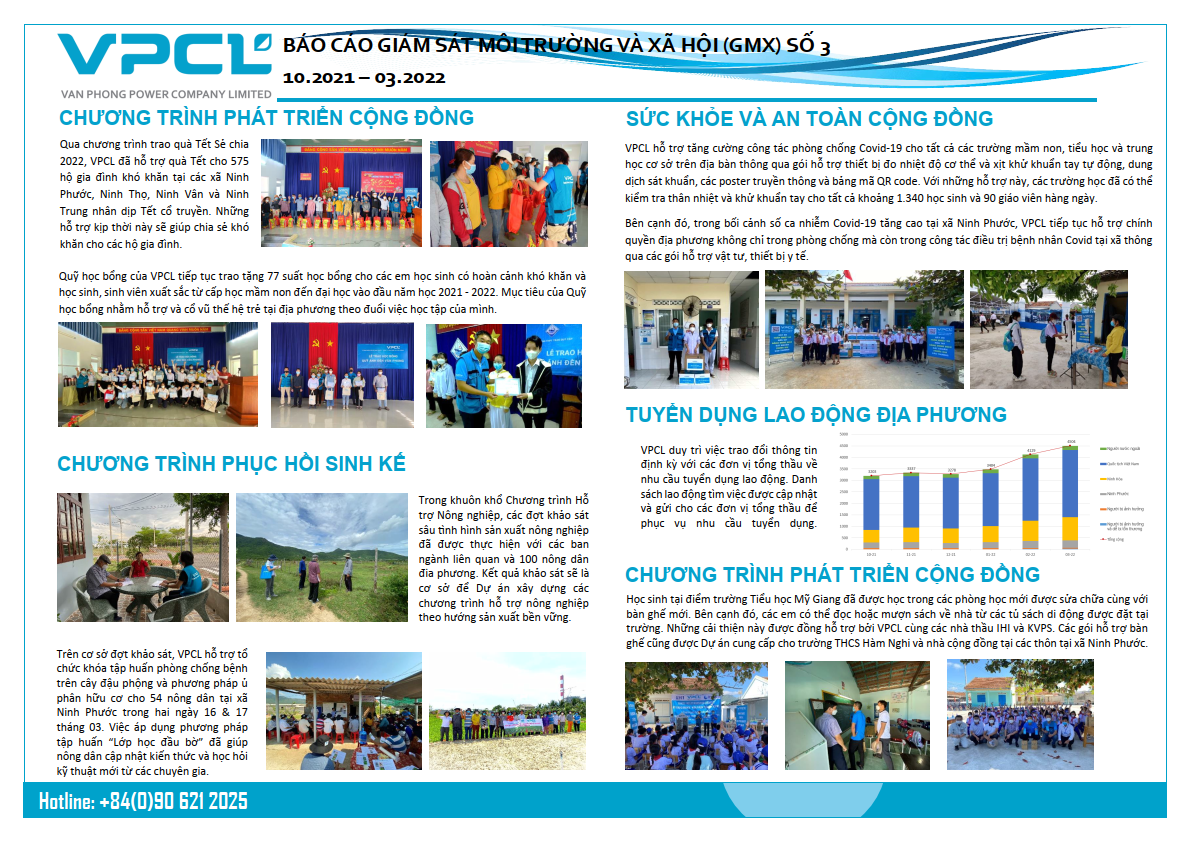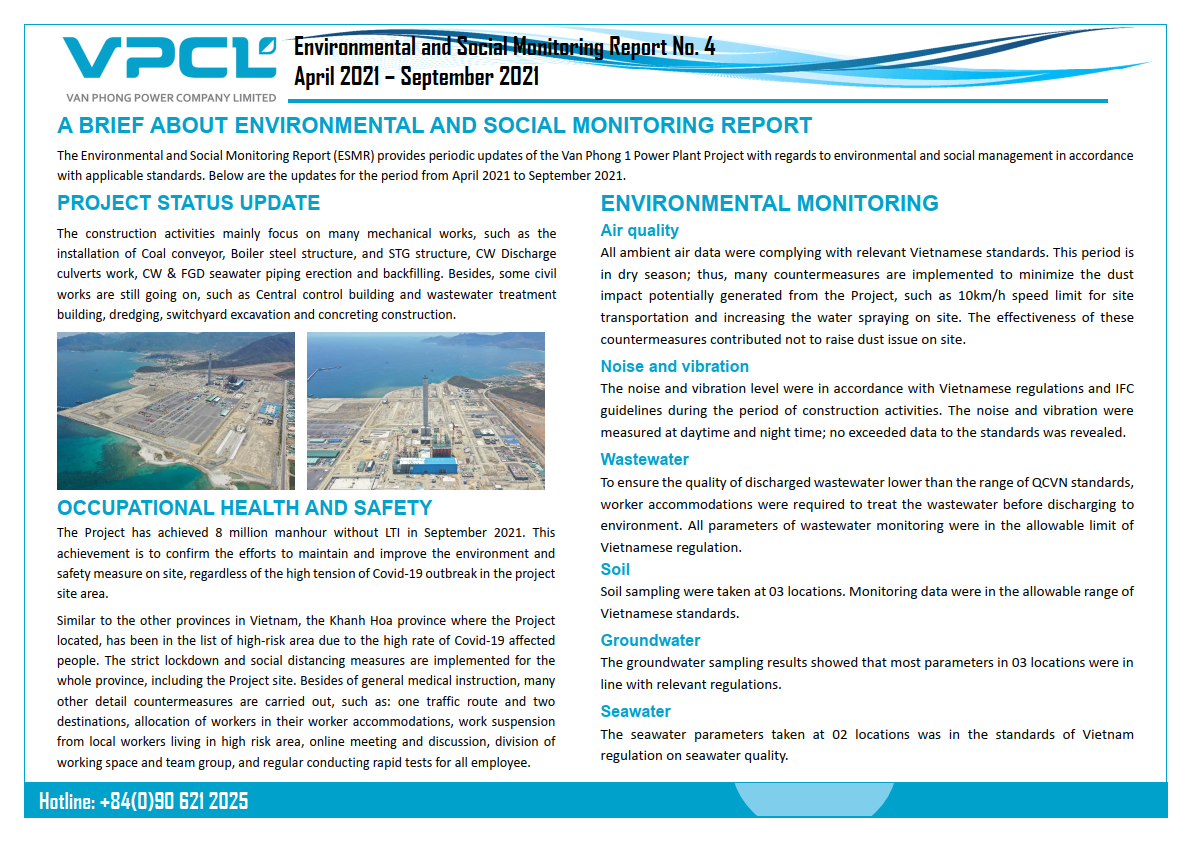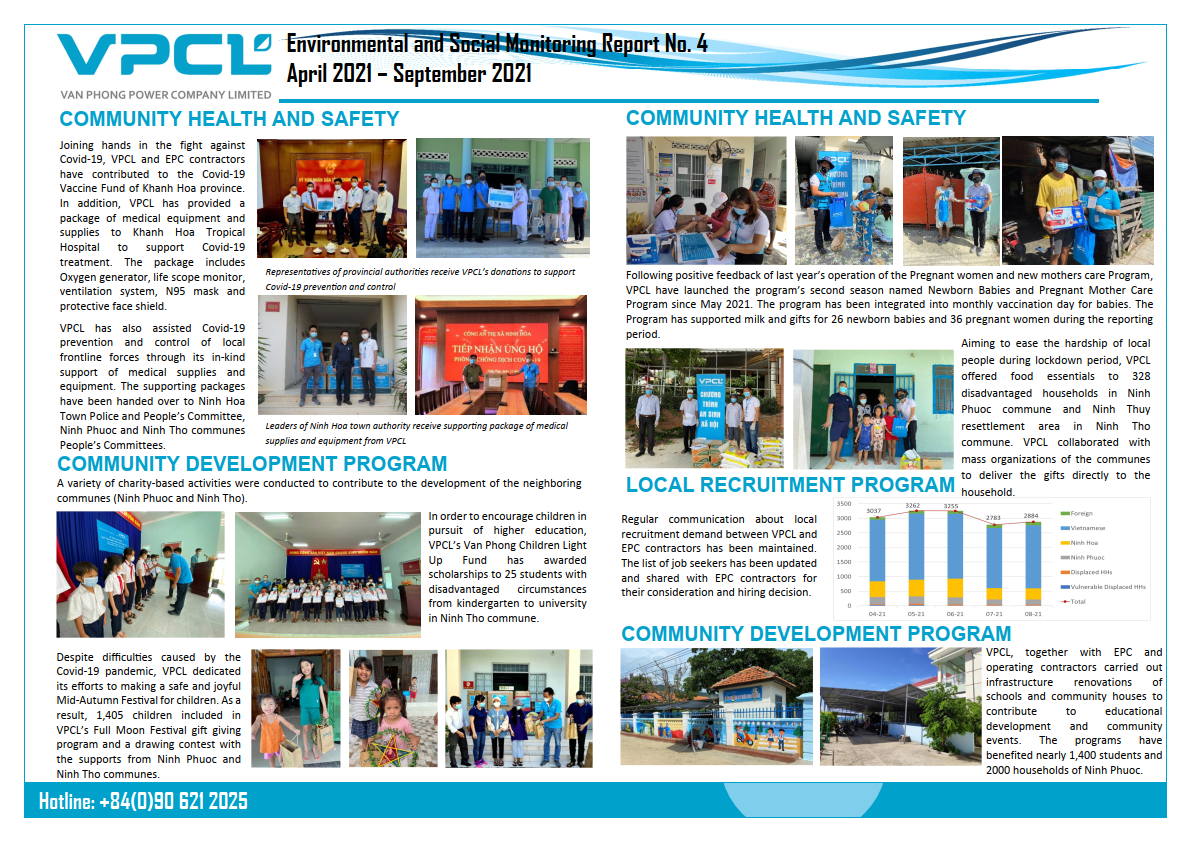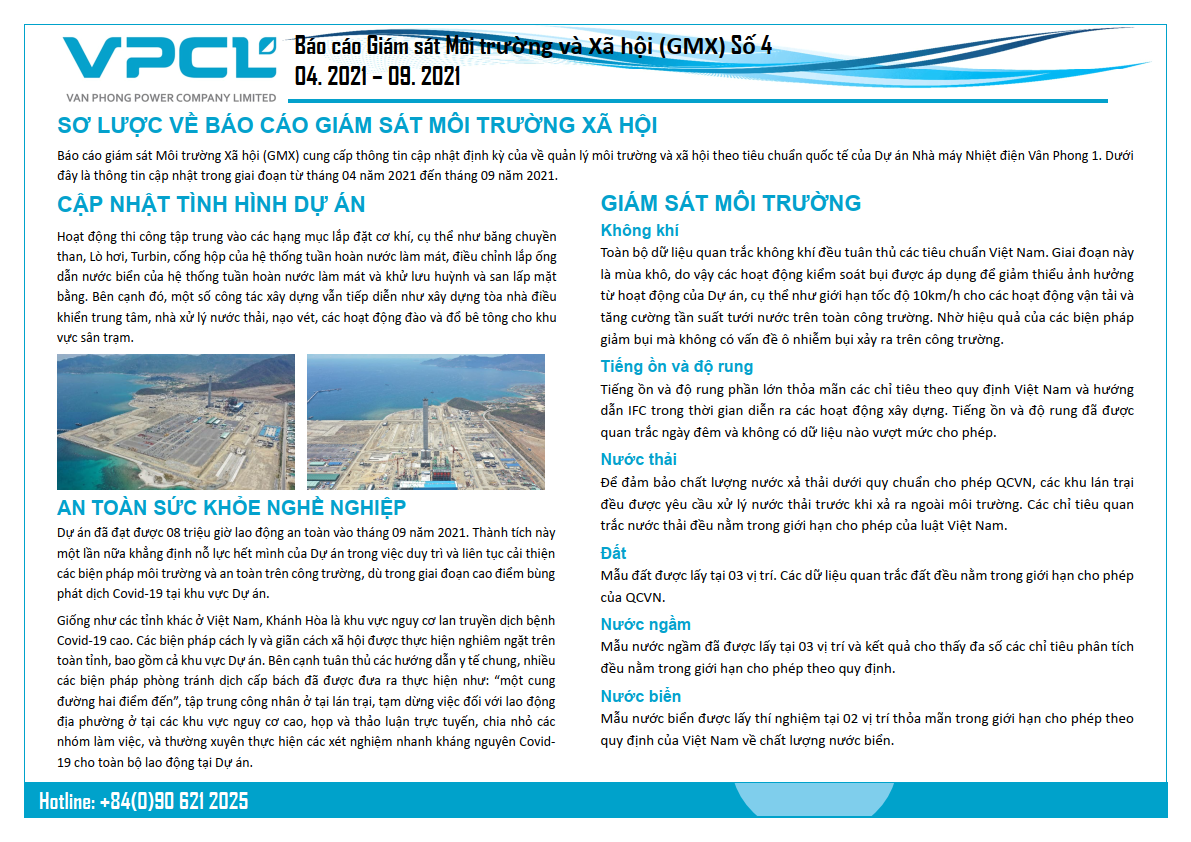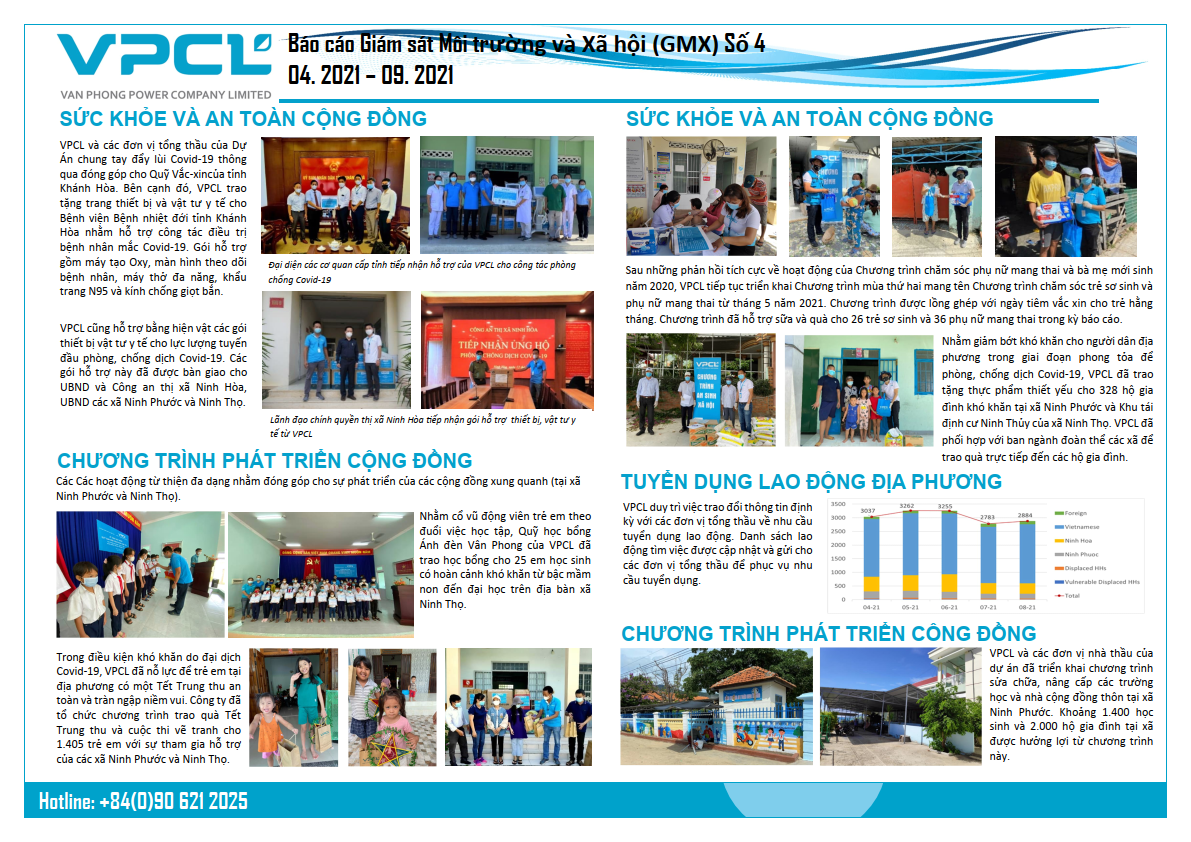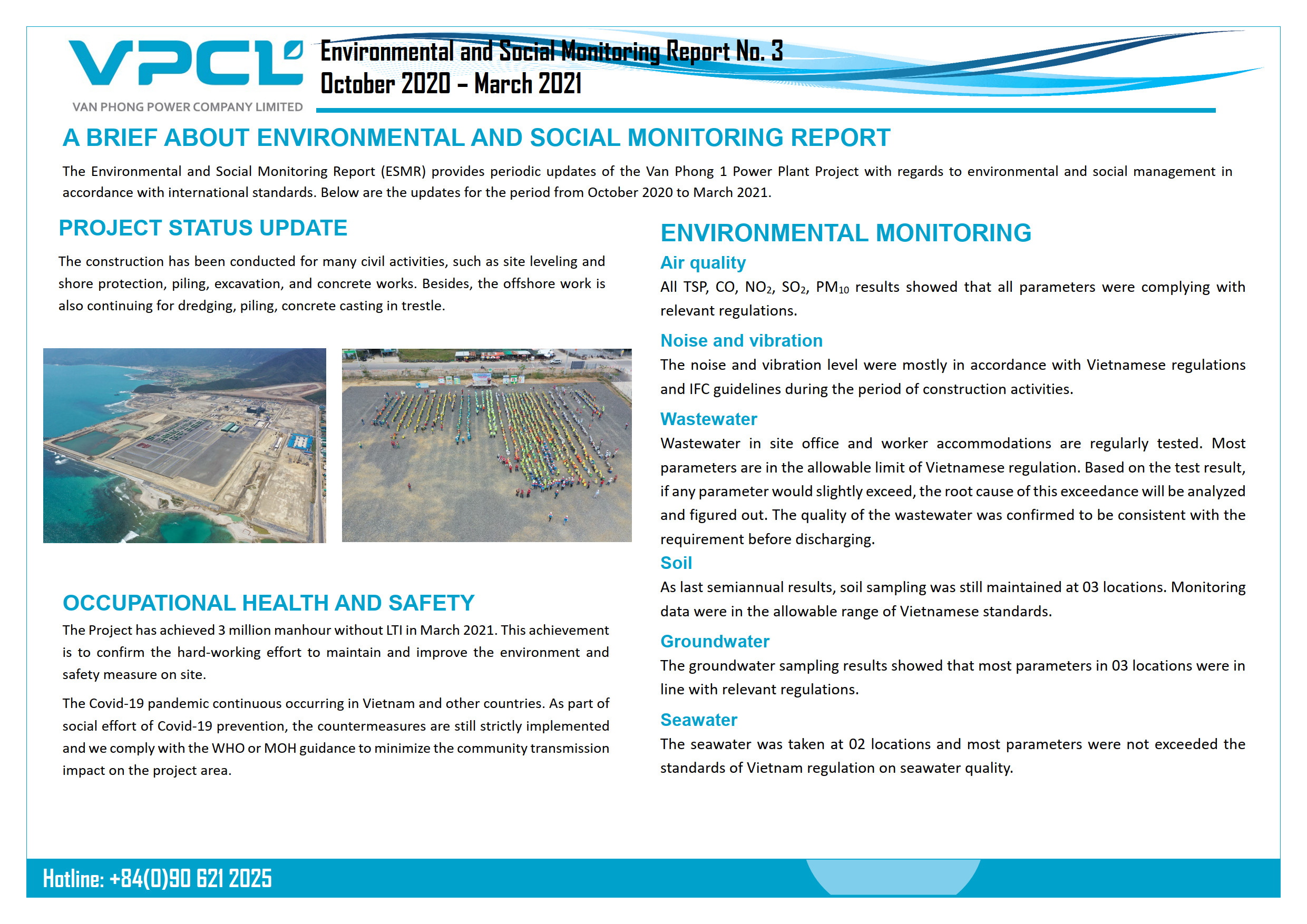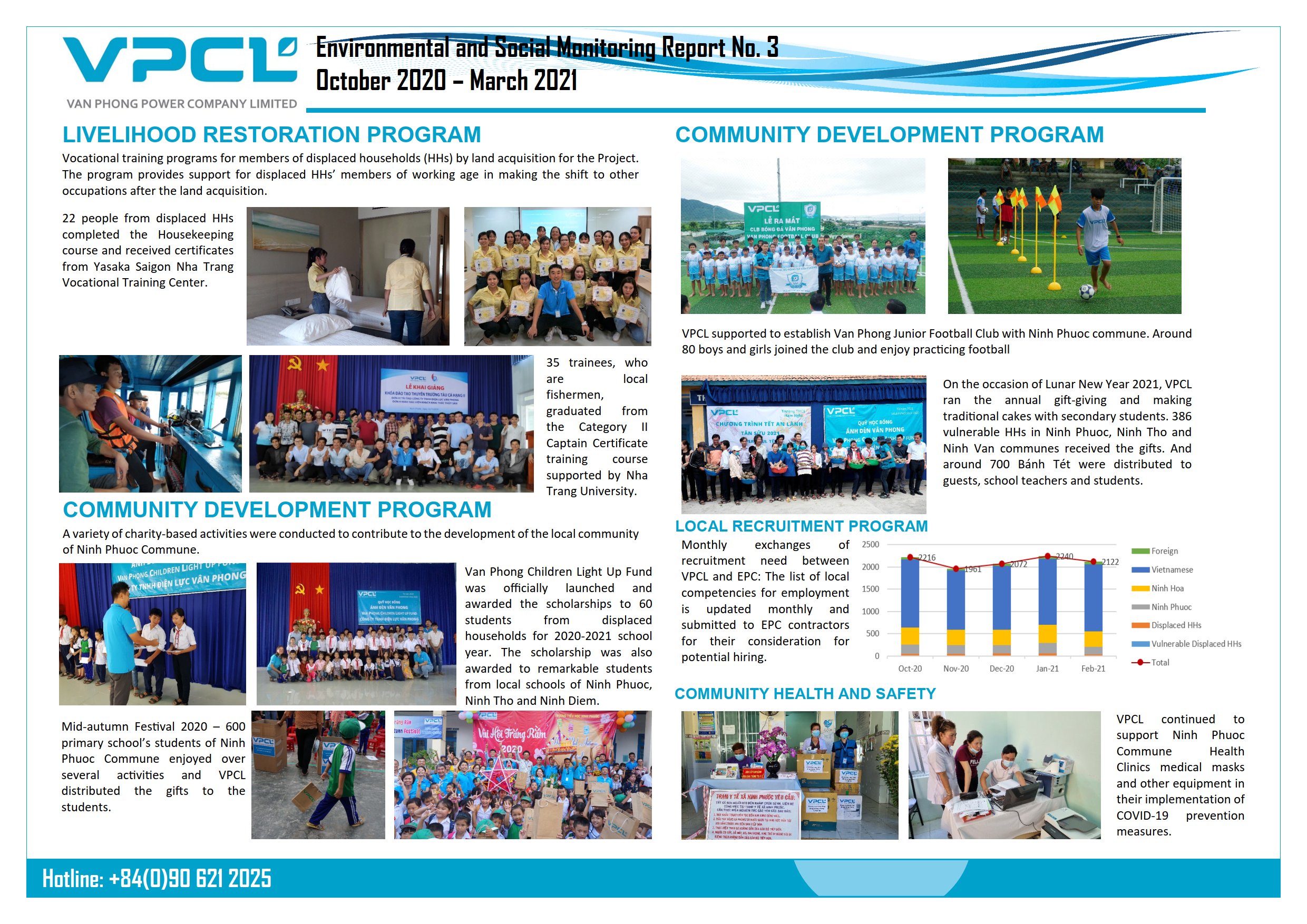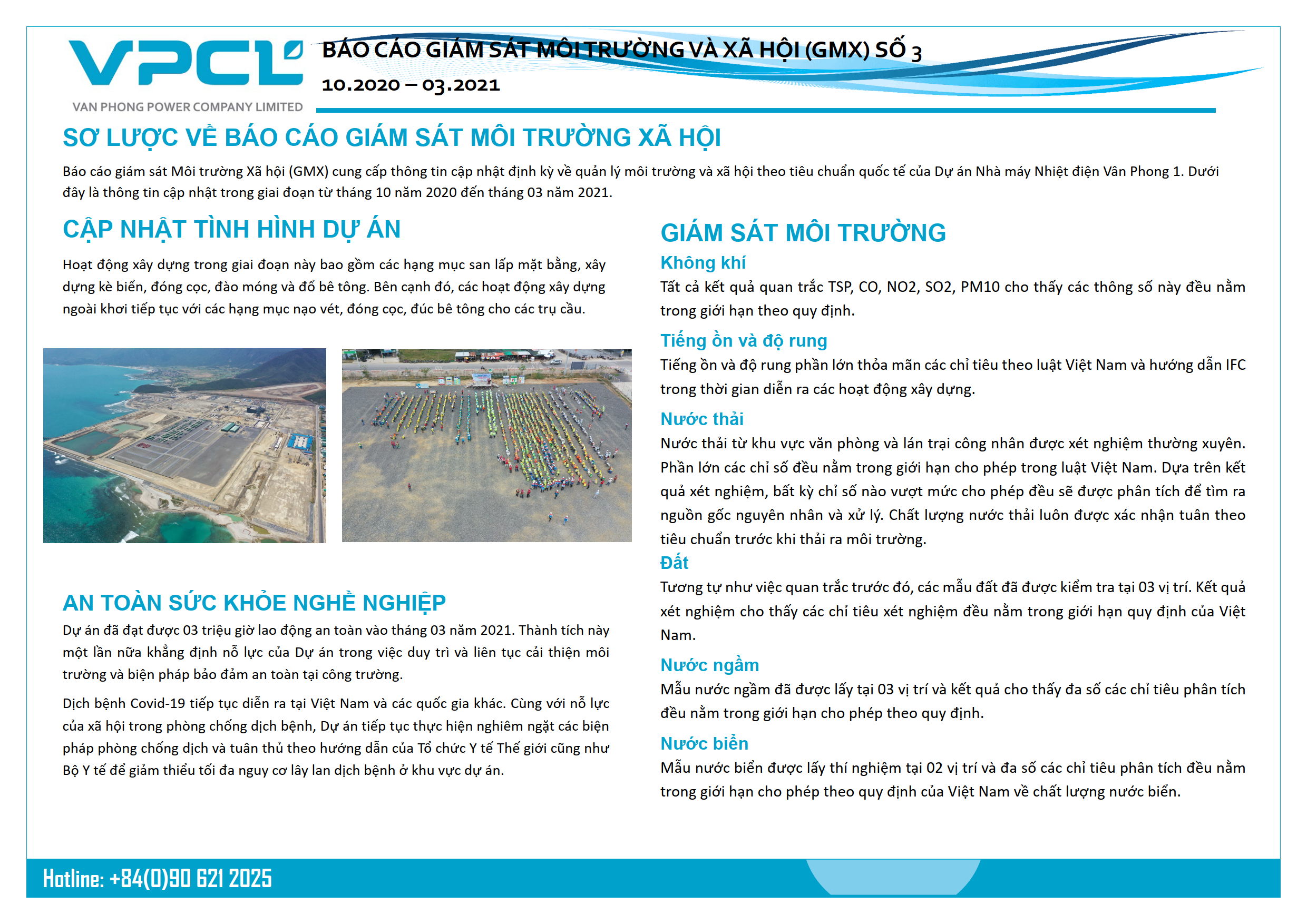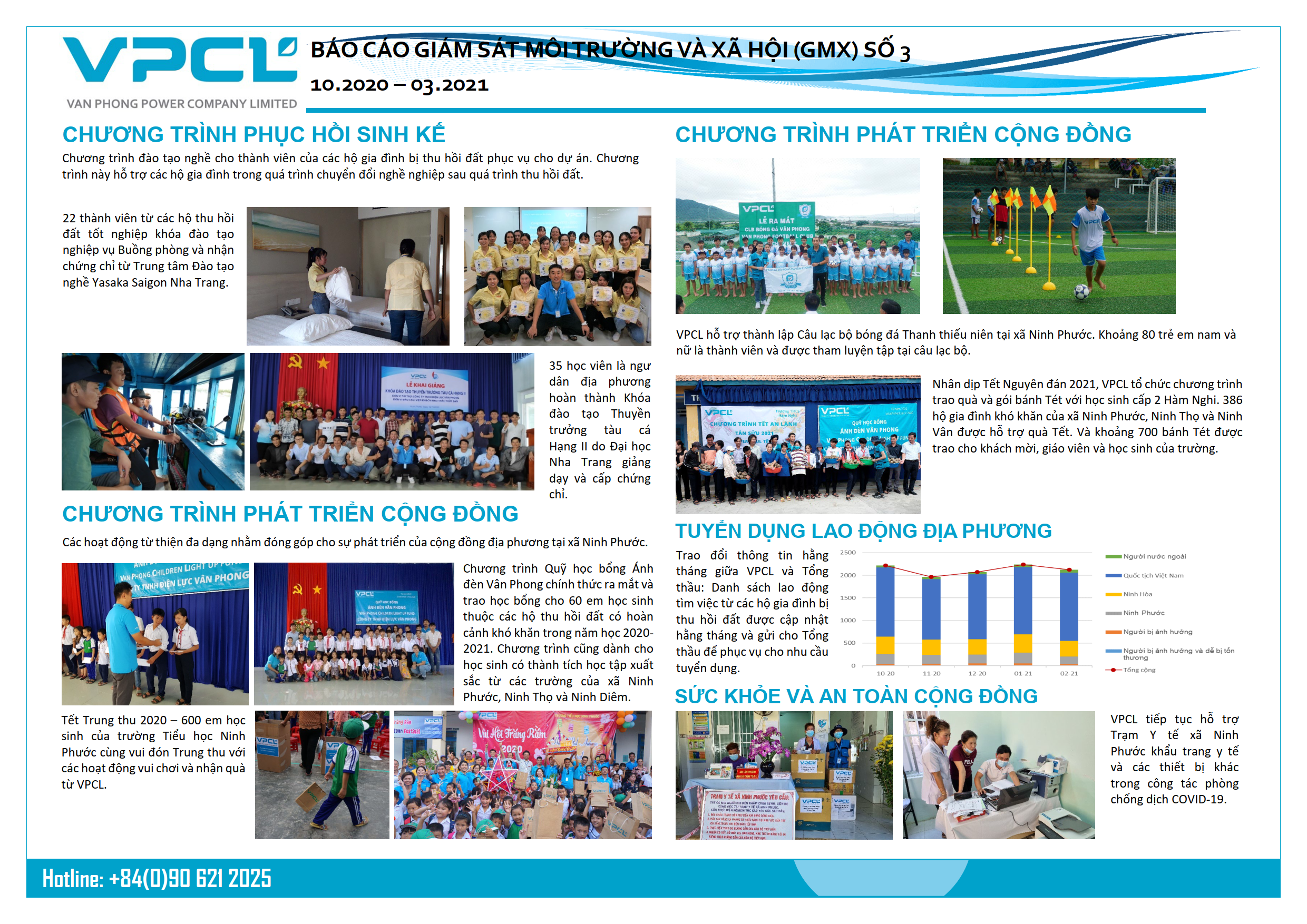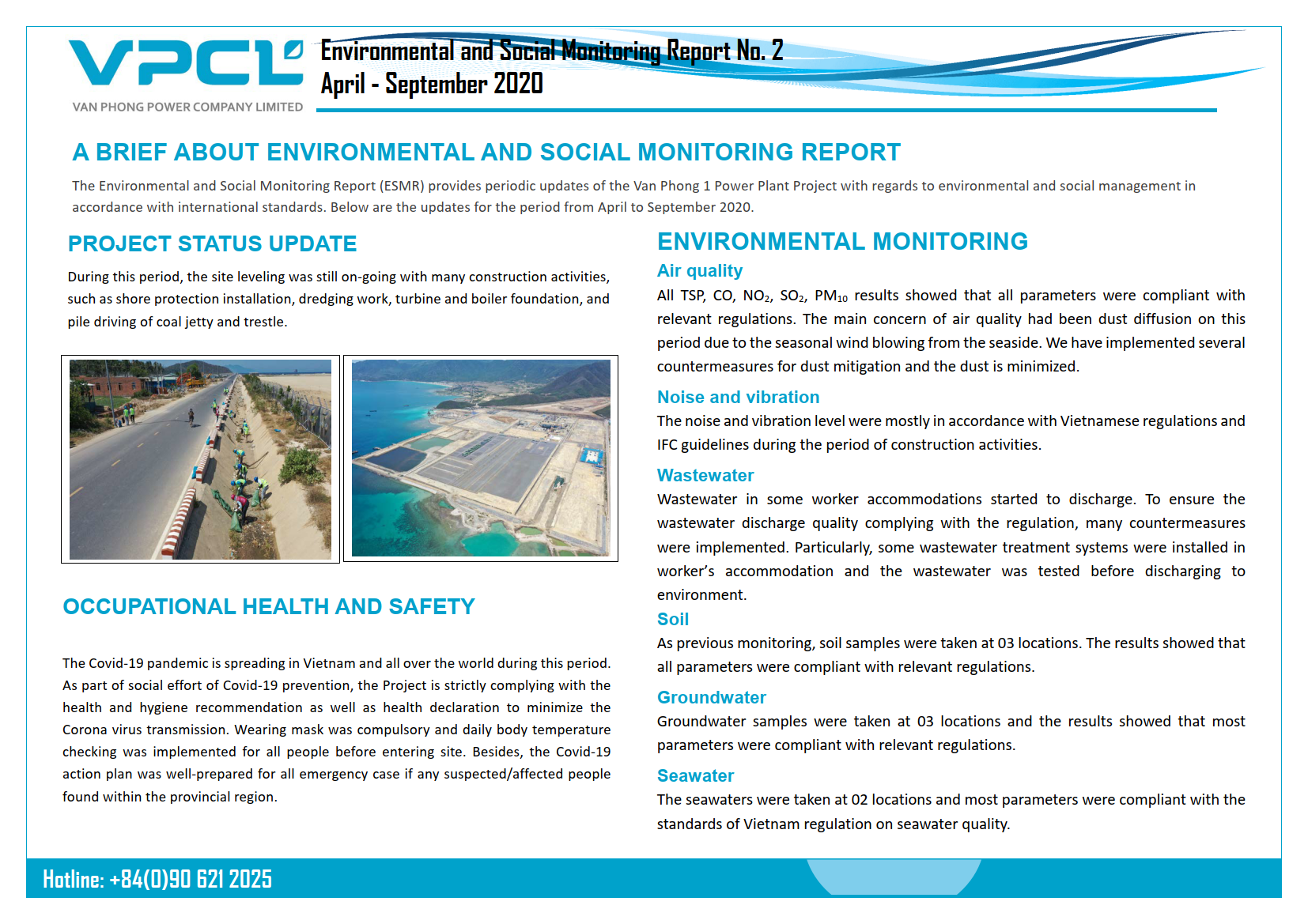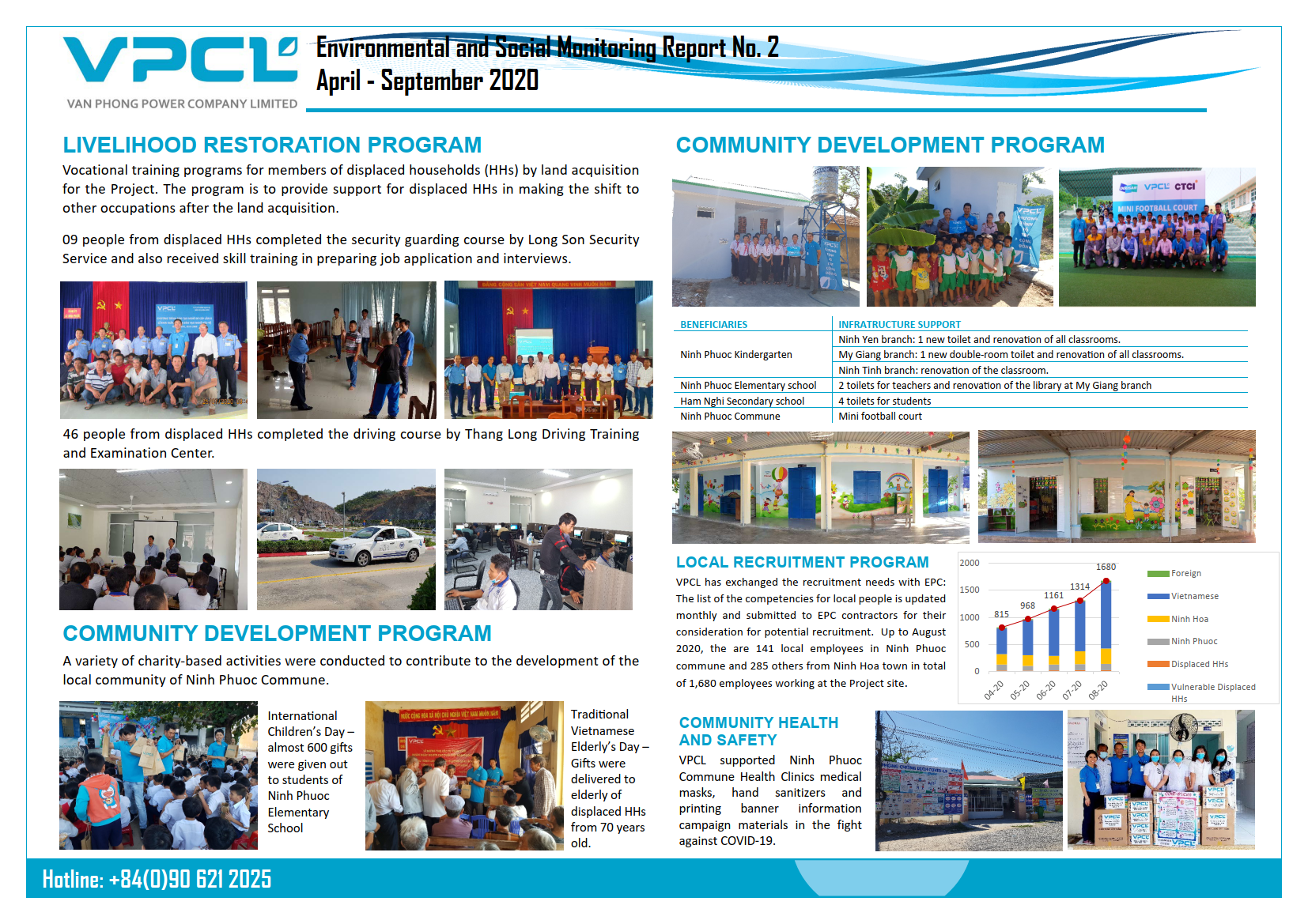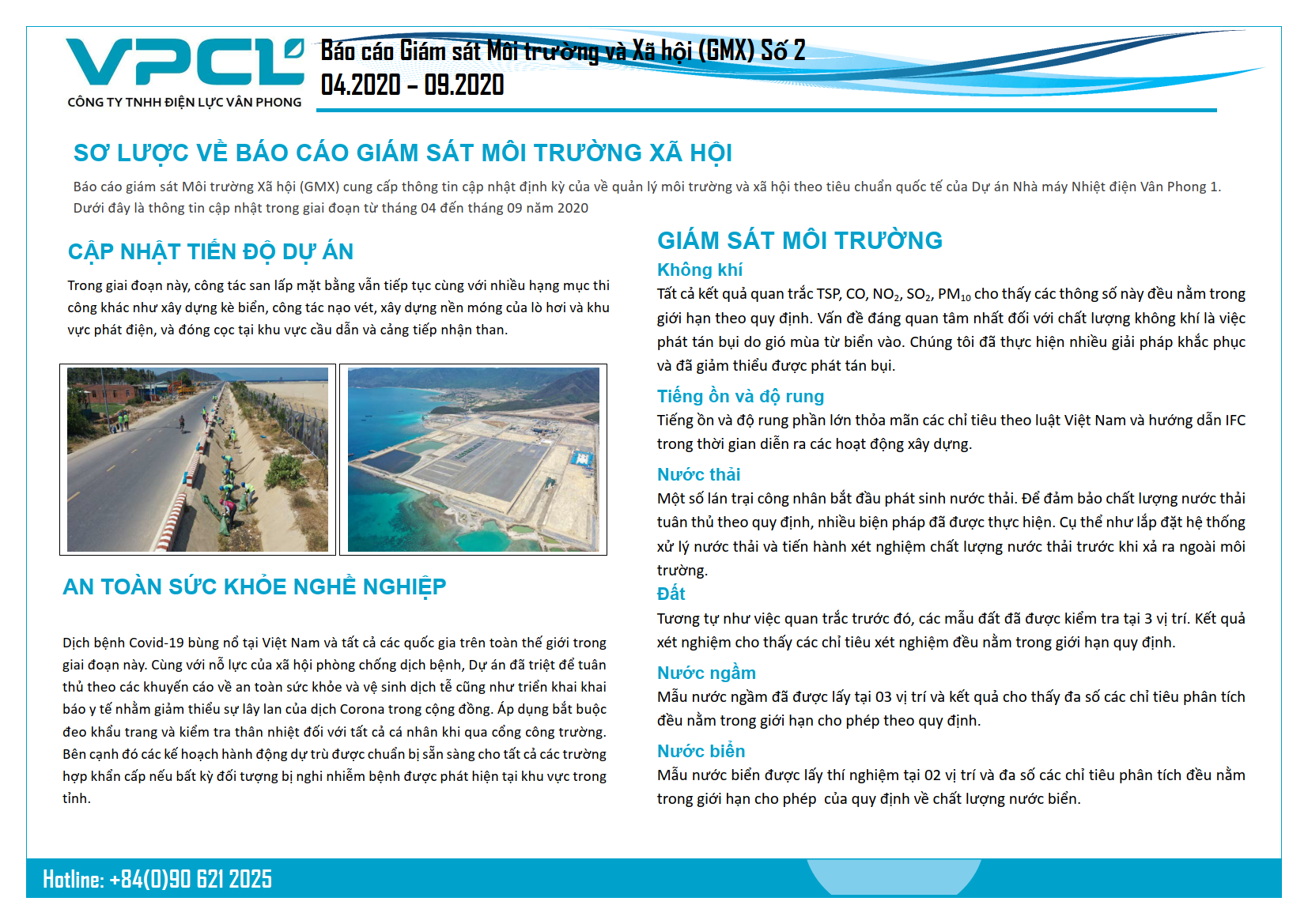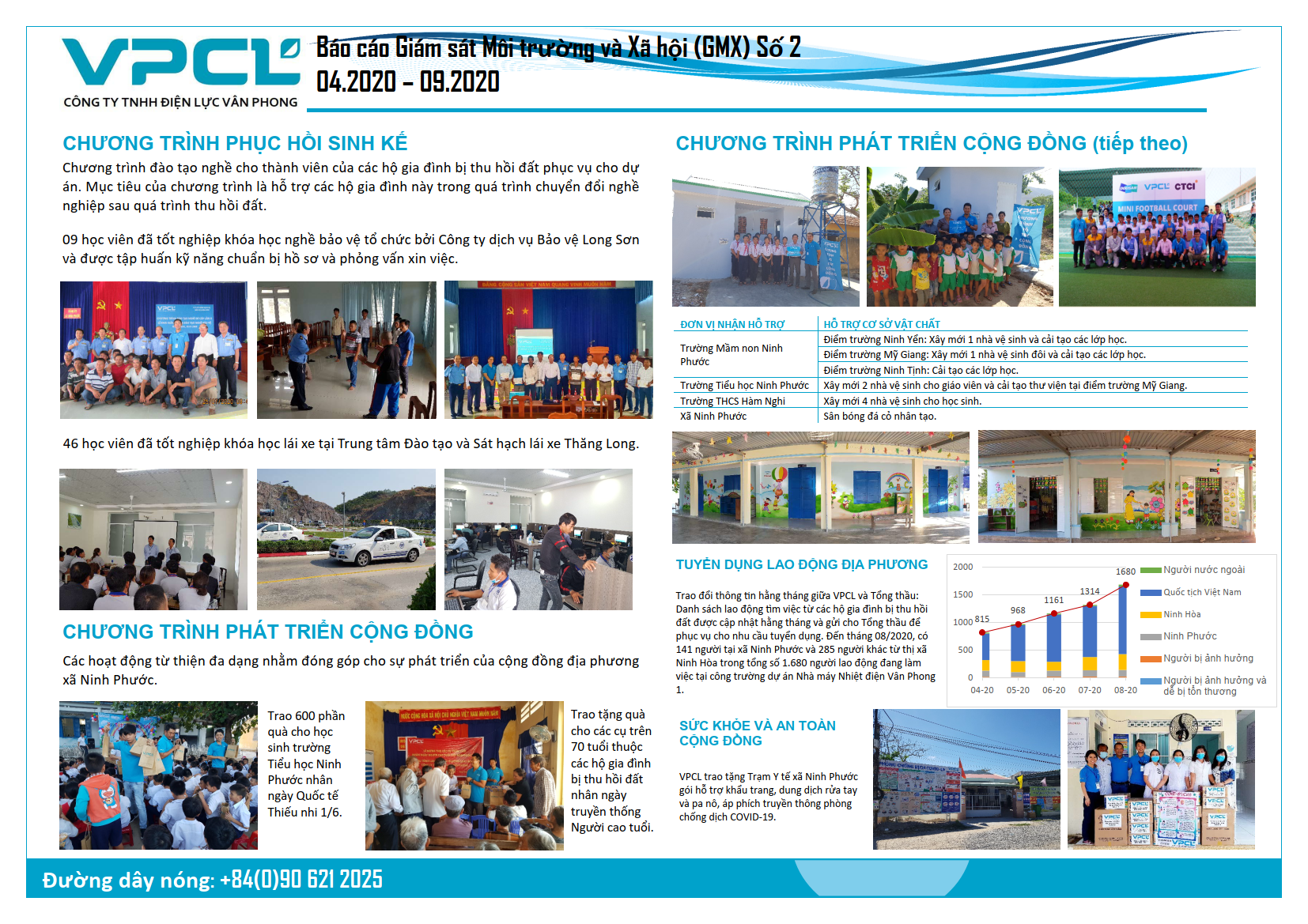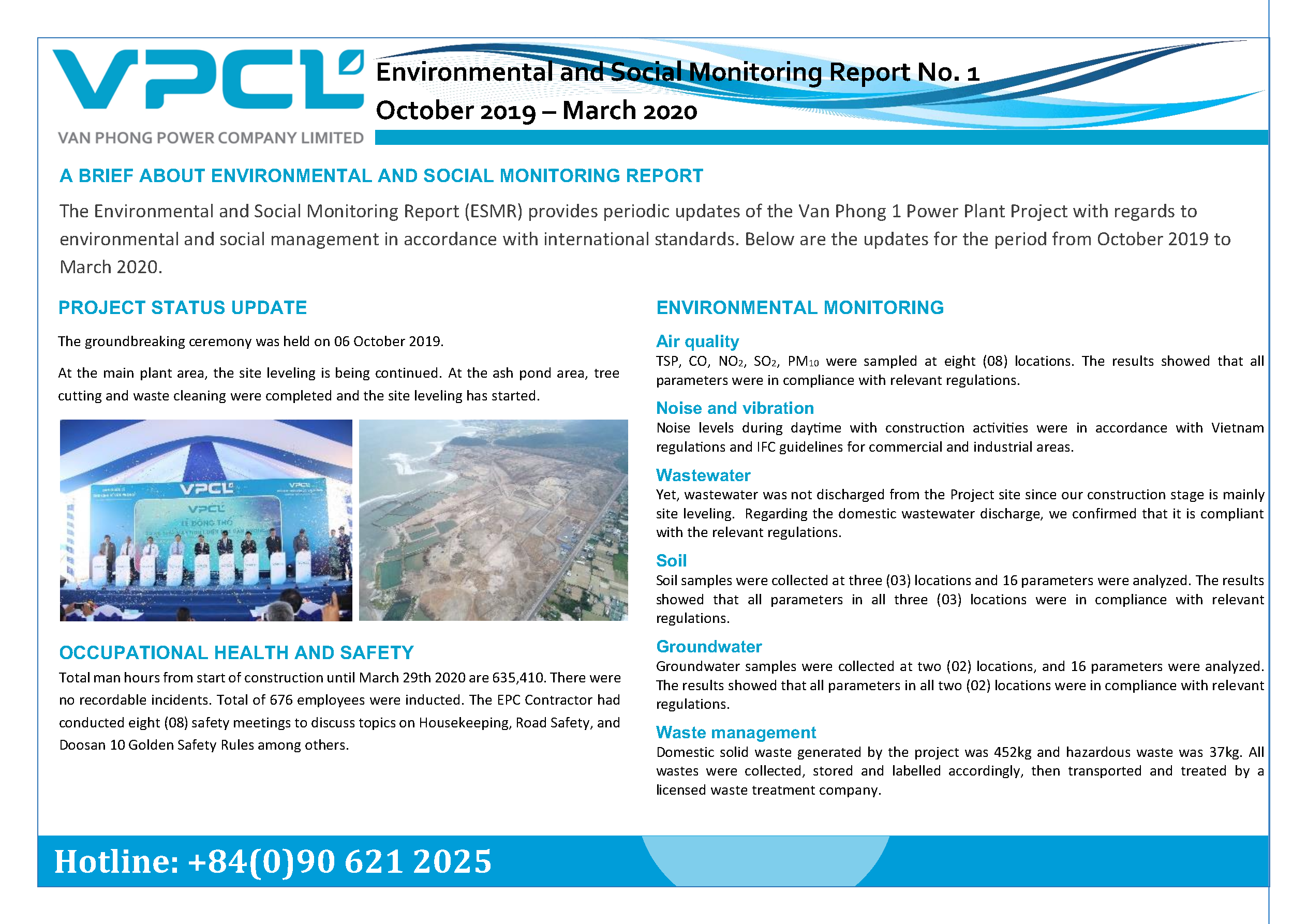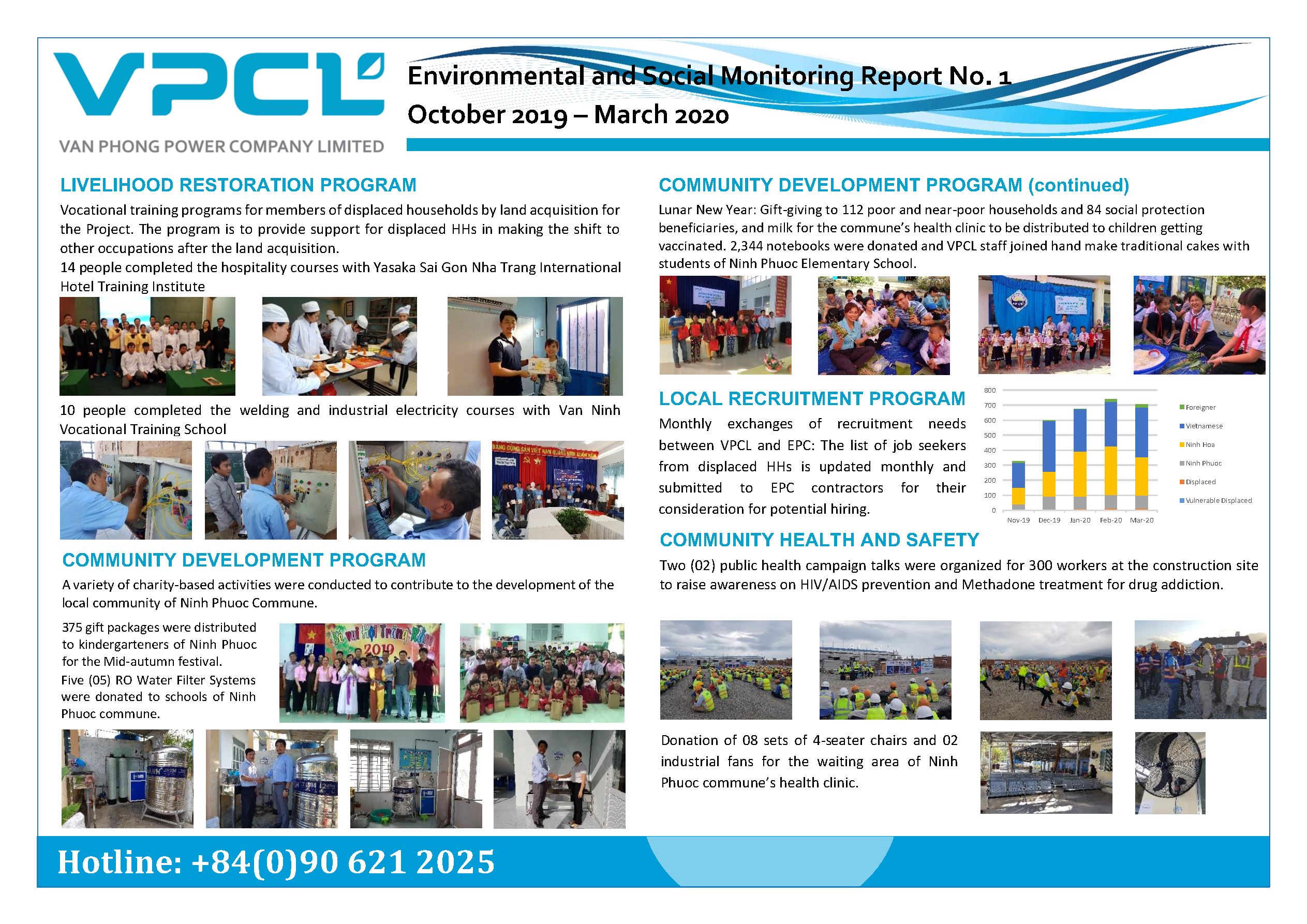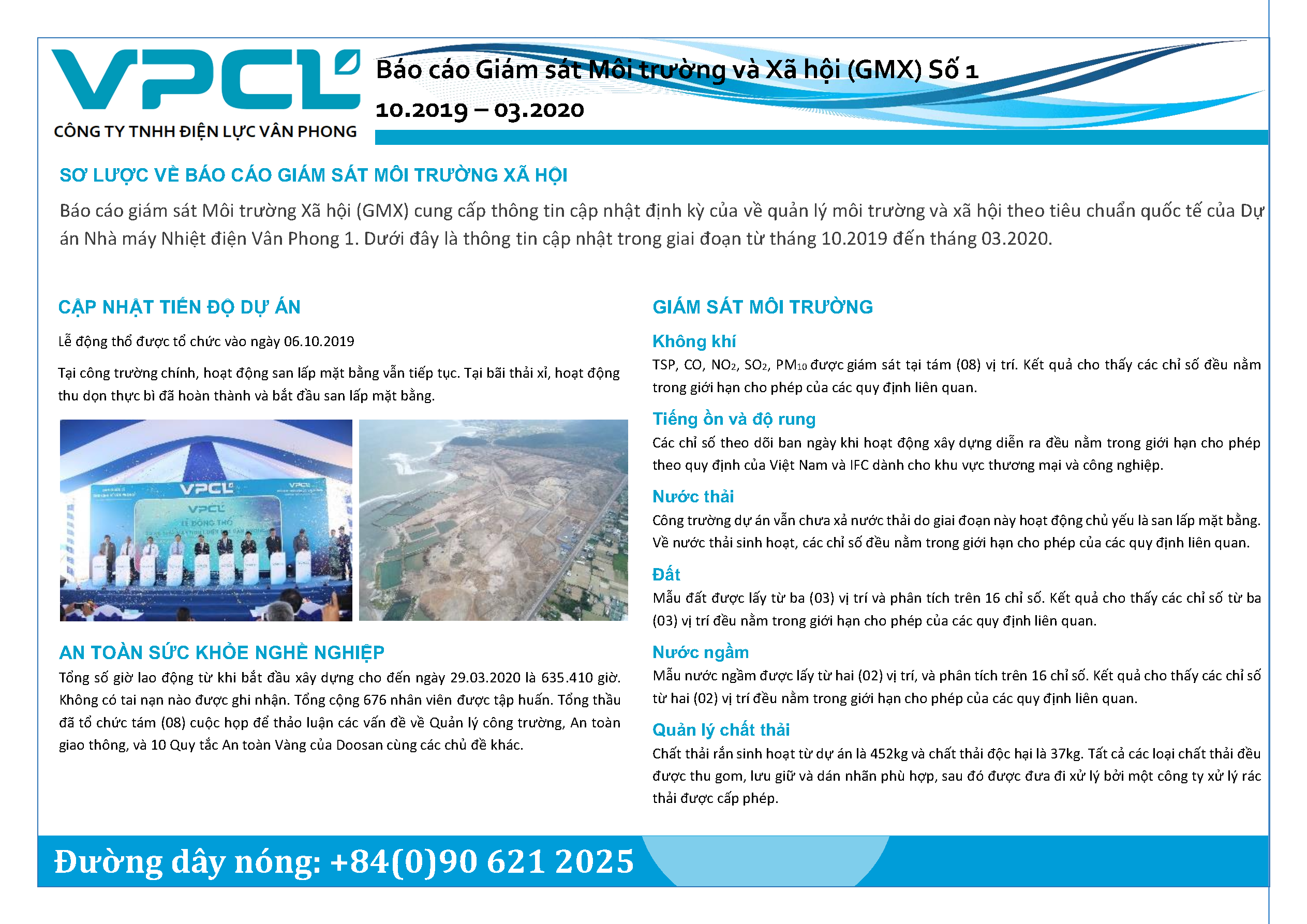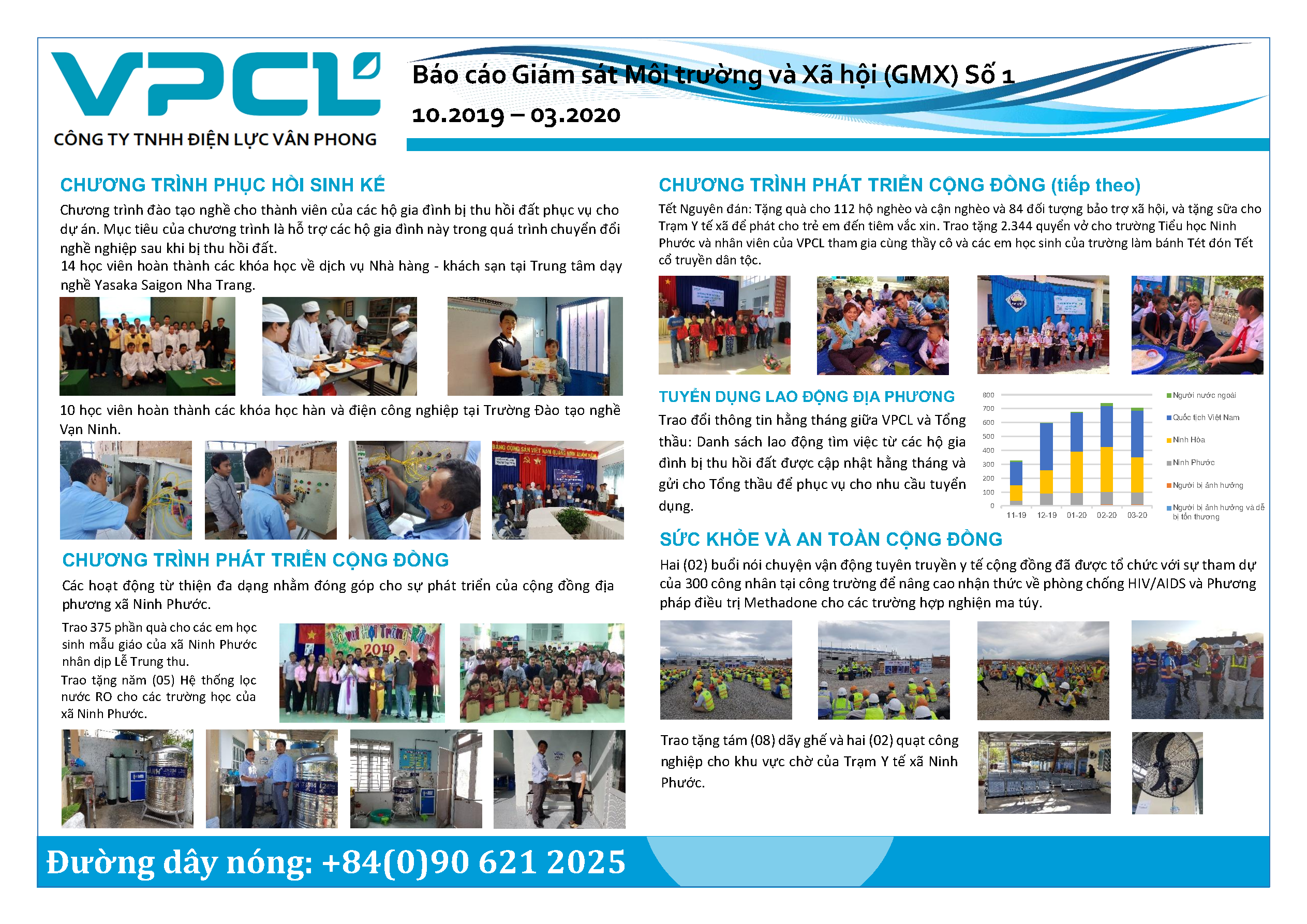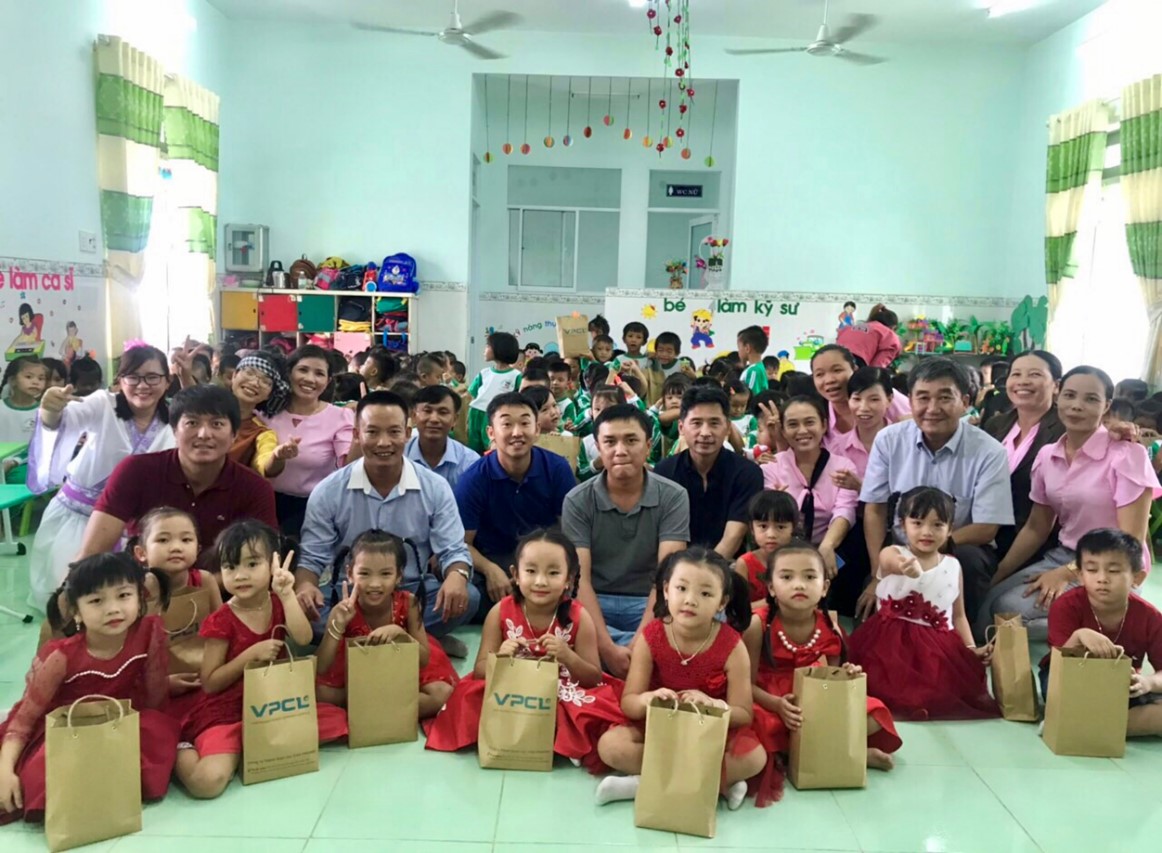Là một thành viên tại cộng đồng địa phương, Công ty TNHH Điện lực Vân Phong (VPCL), chủ đầu tư của dự án Nhà máy Nhiệt điện BOT Vân Phong 1 đã và đang đóng góp tích cực cho an sinh xã hội thông qua các chương trình lồng ghép thực hiện tại các xã Ninh Phước và Ninh Thọ thị xã Ninh Hòa.
About us
Mission
to implement and enhance the balanced values for the society, environment and economy by providing safe, reliable and efficient power to the market
Vision
to be the top-tier power generation company in the market with deep knowledge, prudent practice and excellent performance for the society, environment and economy
Values
Safety: is the first and the foremost for VPCL’s personnel, communities and contractors.
Compliance: to comply with laws and regulations while maintaining the highest ethical standards.
Excellence: to strive to be the best in all that we do and to perform at world-class levels to improve ourselves and the business operation.
Trust: to cultivate the trust of stakeholders in VPCL’s operation and performance, making it the most fundamental and valuable asset of our business.
Environment
Air Quality
Project Dispersion Model and Model Inputs
The CALPUFF dispersion model was used to predict the pollutant concentrations (Particulate, NO2 and SO2) arising from the Project. The inputs for the air dispersion model takes into consideration the environmental conditions at the Project Area.
Ambient Air Quality Standard and Stack Emission Limits
The predicted pollutant concentrations from the air dispersion model was assessed against the National Technical Regulation QCVN 05:2013/BTNMT on Ambient Air Quality Standards, to ensure that ambient air quality at the Project Area is within the stipulated limits. The results of the air dispersion modelling indicated that under normal operating conditions, with the use of electrostatic precipitator, flue gas desulphurisation (FGD) and low NOX burners, the impacts on ambient air quality will comply with the Vietnamese Ambient Air Quality Standards.
For stack emission limits, the Project will adopt the more stringent of the two emission limits, QCVN 22:2009/BTNMT on Emission of Thermal Power Industry and IFC EHS Guidelines for Thermal Power Plants. Therefore, the Project will comply with the national emission limits for NOx and SO2 and the IFC emission guideline for PM. The plant design ensures that the stack emissions are maintained below the Vietnamese/IFC emission limits (see table below).
| Pollutant | Design Value (mg/Nm3) |
Project Emissions Standard (mg/Nm3) |
|---|---|---|
| NOx | 360 | 497 |
| SO2 | 300 | 382 |
| PM | 47 | 50 |
[Note: The Project limit for SO2 was identified through the Environmental Assessment and was based on QCVN 22:2009/BTNMT on Emission of Thermal Power Industry.]
Ongoing Monitoring and Management
The Project will include the installation of continuous emission monitoring systems (CEMS) for emissions monitoring at the stacks.
Social
Overview
A Livelihood Restoration Plan (LRP) and Community Development Plan (CDP) have been developed for the Project. The development of the LRP takes into consideration inputs from the local community. Selected programs proposed within the LRP has also been designed with the needs of vulnerable groups in mind. A Community Grievance Mechanism will be put in place to address local residents’ concerns throughout the Project lifecycle.
During the implementation, the Project Company will carry out consultations with stakeholders to ensure that the LRP is working for the directly displaced households and the economically displaced households. In addition to the LRP, the CDP has been developed to undertake initiatives to further contribute and create benefits for the local communities.
The overall goals of the programs within the LRP and CDP are to ensure that:
- The livelihoods of the directly displaced households and the economically displaced households are restored to pre-existing conditions, and they can pursue these livelihoods without the Project Company’s intervention or support; and
- The Project Company is able to support selected needs of the local communities and contribute to improving the living standards/environment in the long run.
Summary of Livelihood Restoration Plan and Community Development Plan
Livelihood Restoration Plan- Land Based Livelihoods Continuation Program: This program is designed for people who wish to continue farming after the land acquisition process. Training providers will be engaged to assist the people to determine if a more intensive or efficient type of agriculture or aquaculture can be put in place.
- Micro, Small and Medium Business Development Program: This program will aim to build up business awareness and development skills among local communities, to enable them to exploit the business opportunities arising from the Project and development in the region. In the long run, through capacity building achieved under this program, the establishment of micro, small and medium business will contribute to overall local economic development.
- Local Recruitment: The objective of this program is to facilitate employment of local people, thereby supporting livelihood restoration. Preference for Project employment will be given to local residents; especially residents that have been directly affected by Project-related displacement.
- Professional scholarship cum Job Seeker Support: Programs will be put in place to enable communities to pursue vocational training programs. This will enable directly displaced households and economically displaced households to take on skilled occupations and benefit from the emerging economic opportunities offered by the Van Phong Economic Zone (VPEZ). The training programs will offer vocational programs targeted at both men and women, to equip different segments of the society with new skills which are anticipated to be in demand locally.
- Education Development: This program provides secondary and high school students with financial hardship in project affected areas necessary scholarship to pursuit academic education and social skills to adapt with the changing and vibrant environment in VPEZ.
- Charitable Fund: Funds will assist the communities in various aspects. The local communities will be consulted to understand their priorities for on the use of the charitable funds. The objective of this program is to improve the living standards/environment of the local communities.
Prior to implementation, the supporting partners, local authorities and communities will be consulted, and the livelihood restoration, support and community development programs will be refined (if needed) to ensure that the programs are aligned with needs of the local communities. The Project will allocate appropriate resources to support the implementation of the LRP and CDP.
Monitoring and Evaluation
During the implementation, all the on-going programs of LRP and CDP will be monitored by the Project Company to ensure those are operated in line with the objectives and assess if any adjustment and improvement needed for the programs. Post implementation, the Project Company will evaluate the overall effectiveness of the programs.
- Environmental and Social Monitoring Report October 2024 – September 2025 (English)
- Environmental and Social Monitoring Report October 2024 – September 2025 (Vietnamese)
- Environmental and Social Monitoring Report April 2023 – September 2023 (English)
- Environmental and Social Monitoring Report April 2023 – September 2023 (Vietnamese)
- Environmental and Social Monitoring Report October 2022 – March 2023 (English)
- Environmental and Social Monitoring Report October 2022 – March 2023 (Vietnamese)
- Environmental and Social Monitoring Report April 2022 – September 2022 (English)
- Environmental and Social Monitoring Report April 2022 – September 2022 (Vietnamese)
- Environmental and Social Monitoring Report October 2021 – March 2022 (English)
- Environmental and Social Monitoring Report October 2021 – March 2022 (Vietnamese)
- Environmental and Social Monitoring Report April 2021 – September 2021 (English)
- Environmental and Social Monitoring Report April 2021 – September 2021 (Vietnamese)
- Environmental and Social Monitoring Report October 2020 – March 2021 (English)
- Environmental and Social Monitoring Report October 2020 – March 2021 (Vietnamese)
- Environmental and Social Monitoring Report April 2020 – September 2020 (English)
- Environmental and Social Monitoring Report April 2020 – September 2020 (Vietnamese)
- Environmental and Social Monitoring Report October 2019 – March 2020 (English)
- Environmental and Social Monitoring Report October 2019 – March 2020 (Vietnamese)
- ESHIA Summary (English)
- ESHIA Summary (Vietnamese)
- EIA Approval
Community
As a member of the local community, the owner of Van Phong 1 BOT Thermal Power Plant project has been actively contributing to local well-being and society through its integrated programs implementing in Ninh Phuoc and Ninh Tho communes, Ninh Hoa town.
Tháng 1 năm 2020, ca mắc Covid-19 đầu tiên được ghi nhận tại Việt Nam, lần lượt sau đó các tỉnh đều xác nhận bị ảnh hưởng bởi đại dịch này. Kể từ đó, dịch Covid-19 đã và đang lan rộng hầu hết các tỉnh bao gồm Khánh Hòa, gây ảnh hưởng nghiêm trọng đến kinh tế, sức khỏe và chất lượng cuộc sống.
In January 2020, the first case of Covid-19 was reported in Vietnam, then province after province confirmed to be affected by the pandemic. Since then, the pandemic has stretched over almost all provinces including Khanh Hoa province, leaving negative impacts on livelihood, well-being, and quality of life.
Khi cuộc sống khó khăn và khiến con người thoái chí, cha mẹ tìm nguồn vui và động viên trong con cái.
When life is hard and discouraging, parents look into their children to find joy and courage. When solidarity seems like fading in communities, adults look at the young ones and learn from their innocent and unconditional love for one another.
On the full-moon night of 13 September 2019, a few hundred adorable kindergarteners of Ninh Phuoc commune joined VPCL’s managers, engineers and coordinators in the annually endeared celebration of mid-autumn festival.
Our Offices
Contact Info
It would be great to hear from you! If you have any questions, please do not hesitate to send us a message.
-
Van Phong Economic Zone, Ninh Yen hamlet, Ninh Phuoc commune, Ninh Hoa town, Khanh Hoa province, Vietnam
- Phone: +84 24 3824 2864
- Email: vpcl@vpcl.vn








